SELLING WITHOUT RESERVE

NEW YORK | 20 MAY 2025


SELLING WITHOUT RESERVE

NEW YORK | 20 MAY 2025

AUCTION
20 May 2025 at 2.00pm (Lots 1-49)
20 Rockefeller Plaza | New York, New York 10020
EXHIBITION
Saturday, 17 May 10.00am–5.00pm
Sunday, 18 May 1:00pm–5.00pm
Monday, 19 May 10.00am–5.00pm Tuesday, 20 May 10.00am–2.00pm
For further information regarding view dates and times, please visit christies.com or contact: info@christies.com | +1 212 636 2000
AUCTION CODE AND NUMBER
To place bids please contact the Bid department +1 212 636 2437 Please note this sale should be referred to as NATASHA-24250
ABSENTEE AND TELEPHONE BIDS
Tel: +1 212 636 2437
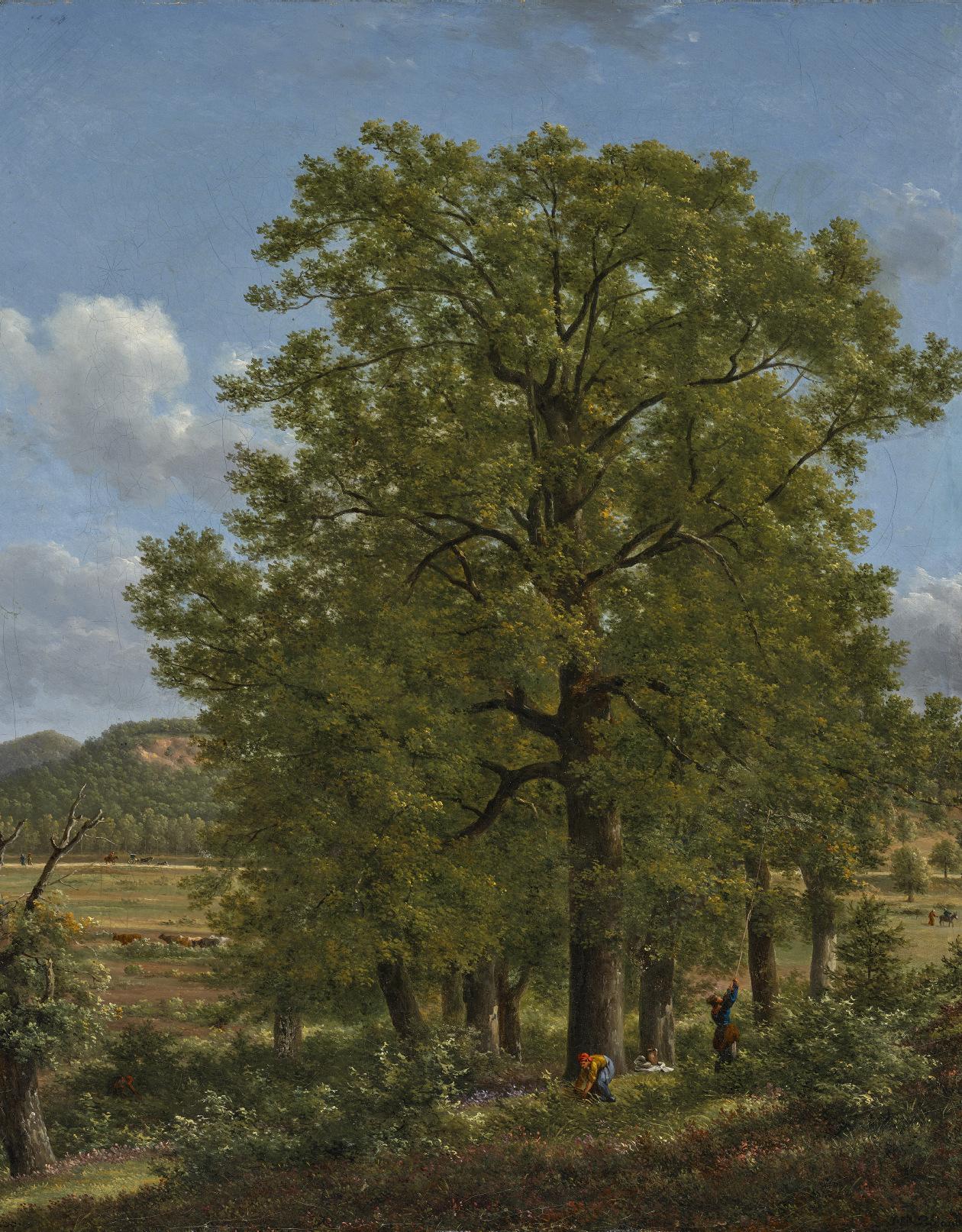
INTERNATIONAL DEPUTY CHAIRMAN
François de Poortere fdepoortere@christies.com
HEAD OF DEPARTMENT
Jennifer Wright jwright@christies.com
HEAD OF SALE, SPECIALIST
Jonquil O’Reilly joreilly@christies.com
SPECIALIST, PRIVATE SALES, AMERICAS
Joshua Glazer jglazer@christies.com
SPECIALIST
Oliver Rordorf orordorf@christies.com
JUNIOR SPECIALIST, HEAD OF PART II SALE
Taylor Alessio talessio@christies.com
CATALOGUER
Kyra Cseh kcseh@christies.com
HEAD OF SALE, SPECIALIST, 19TH CENTURY PAINTINGS
Laura Mathis lmathis@christies.com
CONSULTANT
Alan Wintermute awintermute@christiespartners.com
SALE COORDINATOR
Ginnie Murphy gmurphy@christies.com
Tel: +1 212 636 2159
REGIONAL MANAGING DIRECTOR
Brittany Gersh bgersh@christies.com
Tel: +1 212 636 2168
BUSINESS MANAGER
Natasha Rosenblatt nrosenblatt@christies.com +1 212 636 2165
POST-SALE COORDINATOR
Pearl Katz
Tel: +1 212 636 2605
PAYMENT, SHIPPING AND COLLECTION
Tel: +1 212 636 2650
Fax: +1 212 636 4939
Email: PostSaleUS@christies.com
The sale of each lot is subject to the Conditions of Sale, Important Notices and Explanation of Cataloguing Practice which are set out online, with other important sale information at christies.com. Please see Conditions of Sale at christies.com for full descriptions of symbols used in this publication.
oil on slate, a tondo 14 in. (35.5 cm.) diam.
$30,000-50,000
PROVENANCE:
Bodilly collection, London.
£23,000-37,000
€27,000-44,000
Anonymous sale; Phillips, London, 2 December 1997, lot 48, where acquired by the present owner as 'Angelo Caroselli'.
LITERATURE:
D. Semprebene, Angelo Caroselli 1585-1652: un pittore irriverente, Rome, 2011, p. 95 as 'Angelo Caroselli'.
Published by Daniela Semprebene in 2011 as a work by Angelo Caroselli (loc. cit.), this painting, along with its pendant, were excluded from the more recent monograph by Marta Rossetti (M. Rossetti, Angelo Caroselli (1585-1652), pittore romano: copista, pasticheur, restauratore, conoscitore, Rome, 2015). Rossetti considers both paintings to be by the so-called Pseudo-Caroselli (written communication, 19 July 2023). Possibly of French or Flemish origin, but educated in Rome alongside the better-known Caroselli, Pseudo-Caroselli has been the focus of extensive scholarship (see R. Longhi, ‘Ter Bruggen e la parte nostra’, Vita Artistica, II, 1927, pp. 95-116 and V. Sgarbi ‘Pseudo-Caroselli, La morte di Cleopatra’, Quaderni del Barocco - Dipinti inediti del Barocco Italiano da collezioni private, 16, 2012). Due to the varying quality of paintings attributed to Pseudo-Caroselli, Rossetti argues that the pseudonym encompasses more than just one artist active in the ambit of Angelo Caroselli (M. Rosetti, I pittori della luce: da Caravaggio a Paolini,V. Sgarbi ed., exhibition catalogue, Milan, 2021, pp. 139-141). She further notes that the roughly thirty paintings ascribed to PseudoCaroselli are linked by moralizing—often necromantic and erotic—themes and are frequently executed on less common supports, such as slate and copper. This rosy-cheeked couple painted on slate is therefore a typical example of PseudoCaroselli's work.
Rossetti has proposed that Pseudo-Caroselli (or at least one of the artists encompassed by this sobriquet) may be identifiable as one ‘Francesco orefice pigionante...’ (Francesco, goldsmith, tenant) who lived with Angelo Caroselli in 1642-43. This Francesco, who according to archival evidence was also a painter, could be the son of the Parisian goldsmith and jeweler Henri Cousin (M. Rossetti, 2015, op. cit., pp. 453, 596 & 598). Indeed the meticulously sculptural, almost trompe l’oeil rendering of lace, gold, and still-life elements of Pseudo-Caroselli’s paintings make such an identification particularly convincing.
We are grateful to Prof. Marta Rossetti for endorsing the attribution of this painting to Pseudo-Caroselli on the basis of photographs.


The Madonna and Child with a female saint presenting them with fruit oil on panel, a tondo 33Ω in. (85 cm.) diam.
$50,000-70,000
PROVENANCE:
£38,000-52,000
€44,000-61,000
Baron Alfred de Rothschild (1842-1918), Seamore Place and Halton House, Cheshire, by descent to Marchioness Curzon of Kedleston; her sale, American Art Association, 22 April 1932, lot 75, as 'Gianpietrino'.
[Property of an Estate]; Sotheby's, New York, 30 May 1991, lot 4, as 'Niccolò Soggi', where acquired by the present owner.
The composition draws upon Leonardesque prototypes, notably recalling the Madonna and Child with Lamb in the Pinacoteca di Brera (attributed to Fernando Yáñez de la Almedina; inv. no. 1162), and echoing the engaging pose of Lorenzo di Credi’s Madonna di Piazza in Pistoia Cathedral. Dr. Laura Pagnotta notes further analogies between facial types in the present painting and those in di Credi’s Sacra Conversazione (Paris, Musée du Louvre, inv. no. MI 598), as well as in his tondo in the Pinacoteca Querini Stampalia (Venice, inv. no. 4/73). She also observes the present painting’s affinities with a tondo formerly attributed to Giuliano Bugiardini—though, as suggested by Pagnotta, more plausibly linked to the circle of Raffaellino del Garbo—depicting the Holy Family (Genoa, Musei di Strada Nuova – Palazzo Bianco, inv. no. 273). The landscape’s northern-inspired architectural motifs, while common in many Tuscan paintings of the early Cinquecento, appear with particular frequency in paintings by di Credi and his circle.
We are grateful to Dr. Laura Pagnotta for her assistance in cataloguing the present painting and for generously sharing her observations, which form the basis of this entry (written communication, 24 April 2025).


Coriolanus persuaded by his family to raise the Siege of Rome
signed and dated 'Filippus Abb... / Pinxit 166[1]' (lower left, on the drum) oil on canvas
79¬ x 121¿ in. (201.9 x 309.6 cm.)
$60,000-80,000
PROVENANCE:
The heirs of Luzzatto, Venice. with Italico Brass (1870-1943), Venice, by 1929.
£46,000-60,000
€53,000-70,000
Sotheby's Parke Bernet, Florence, 14 November 1978, lot 659, described as The Family of Darius before Alexander [The Property of a Gentleman]; Christie's, London, 13 December 1996, lot 119, where acquired by the present owner.
LITERATURE:
G. Fiocco, La pittura veneziana del Sei e Settecento, Verona, 1929, p. 39, as Filippo Gherardi. C. Baroni, 'Filippo Abbiati maestro del Magnasco', Archivio Storico Lombardo, III, 1951-52, p. 213.
C. Merzagora, Filippo Abbiati, PhD dissertation, 1965-66, under rejected works (see Zuffi 1986, note 6, op. cit.).
R. Pallucchini, La Pittura Veneziana del Seicento, Milan, 1981, I, p. 279 and II pp. 804-805, fig. 837, described as The Family of Darius before Alexander S. Zuffi, ‘I dipinti per i Borromeo nell'evoluzione di Filippo Abbiati’, Paragone, 1986, pp. 73 and 82, note 6, no. 441.
S. Zuffi, 'Filippo Abbiati', La pittura in Italia: il Seicento, II, Milan, 1989, p. 607.
F. Frangi, 'La Pittura a Milano negli anni della formazione di Magnasco', Alessandro Magnasco 1667-1749, exhibition catalogue, Milan, 1996, pp. 77-78 and 86, notes 3 and 4, fig. 1.
Filippo Abbiati, born in Milan, was the pupil of Carlo Francesco Nuvolone. Admitted to the Accademia Ambrosiana in 1669, he had a long and successful career in his native city. He was the teacher of the Genoese master Alessandro Magnasco, who entered his workshop around 1681-1682.
This painting is Abbiati’s earliest known dated work, which Rodolfo Pallucchini (loc. cit.) ascribed to his time spent in Venice at the onset of his career, reflecting the influence of Antonio Zanchi. In the early 20th century, when the painting belonged to Italico Brass (1870-1943) it formed part of a cycle of three paintings depicting episodes from the history of Rome. As with this work—which has previously been described as Darius and his family before Alexander the Great—the subjects of the other two paintings may not have been correctly identified in the literature. First documented by Giuseppe Fiocco in 1929 (loc. cit.) as depicting the stories of Alexander and Darius, the other two works have alternatively been interpreted as The meeting of King Turnus and Camilla and Hannibal seeing the head of Hasdrubal (see Zuffi, 1986, loc. cit.).


An alchemist in his study with two assistants in the background
signed 'TWyck' ('TW' linked, on the tablecloth, lower center, strengthened) oil on panel 16¿ x 14¬ in. (41 x 37.2 cm.)
$40,000-60,000
PROVENANCE:
£31,000-45,000
€36,000-53,000
Private collection, France. Anonymous sale; Druout Rive Gauche, Paris, 21 March 1980, lot 57. with Johnny van Haeften, Ltd., by March 1989. with Galerie Sanct Lucas, Vienna, by 1989 until at least 1996. Anonymous sale; Sotheby's, New York, 28 January 1999, lot 421A, where acquired by the present owner.
EXHIBITED:
Vienna, Galerie Sanct Lucas, Gemälde Alter Meister Winter, 1989-1990, no. 7. Vienna, Galerie Sanct Lucas, Old Master Paintings, Winter 1996, no. 16.
LITERATURE: Advertisement, The Burlington Magazine, March 1989, p. xxxiii, illustrated.
The practice of alchemy, a blend of philosophy, magic, chemistry, and astrology, flourished in Early Modern Europe. Its practitioners famously sought the secret to transform lead into gold and to discover the elixir of life. Elias Ashmole, Tycho Brahe and Issac Newton all published alchemical texts in addition to their early scientific discoveries. Thomas Wijck favored the subject of the alchemist’s study and painted it on numerous occasions. The glass alembic perched atop a furnace in the foreground, the piles of texts, and the exotic reptile hanging from the ceiling are all common symbols of the alchemist’s trade and appear in many of Wijck’s compositions, including examples at The Menil Collection, Houston (inv. no. 1967-31), The Mauritshuis, The Hague (inv. no. 469) and the Rijksmuseum, Amsterdam (inv. no. SK-A-489).

elderly woman counting coins
oil on canvas
28¡ x 23¡ in. (72 x 59.3 cm.)
$40,000-60,000
PROVENANCE:
Private collection, Paris, by 1946.
£31,000-45,000
€36,000-53,000
Anonymous sale; Jean-Louis Picard, Drouot Montaigne, Paris, 24 June 1993, lot 13, as Heyman Dullaert.
Anonymous sale; Sotheby's, London, 20 April 1994, lot 55, as Jacques des Rousseaux, where acquired by the present owner.
LITERATURE:
W. Sumowski, Gemälde der Rembrandt-Schüler, VI, Landau/Pfalz, 1994, pp. 3525 and 3534, note 84, and 3573, illustrated, titled Allegory of Avarice
Although little is known of Jacques des Rousseaux’s early life, he is thought to have spent time in the studio of Rembrandt van Rijn around 1628. During his training, he learned to closely reproduce his master’s tronies, characterful studies of expression not meant to capture likeness, which on occasion functioned as allegories. The carefully observed wrinkles of the woman’s face and hands, as well as the muted palette of the present painting both reflect the lasting influence that Rembrandt's studio had on des Rousseaux. Werner Sumowski (loc. cit.), who dated the work to 1635, gave it the title of ‘Allegory of Avarice’. Prior to this, the painting had been called ‘Le Changeur’ (The Money-Changer) when it appeared at auction in France in 1993 (see Provenance). The theme of a woman counting coins would have brought to mind for contemporary viewers the Parable of the Rich Fool. This subject was treated by Rembrandt and his followers, which warns against the dangers of greed and futility of pursuing material wealth, since true riches according to the Gospel lies not in possessions, but in a relationship with God (Luke 12: 13-15).
A nearly identical composition, attributed to Joachim von Sandrart I, appeared at auction in 2000 (Lempertz, Cologne, 20 May 2000, lot 738).

Soldiers and a woman nursing a child around a fire
signed with monogram and dated 'PQ / 1639' ('PQ' linked, lower left) oil on panel
14√ x 18 in. (37.7 x 45.7 cm.)
$20,000-30,000
PROVENANCE:
£16,000-23,000
€18,000-26,000
Anonymous sale; Sotheby's, Amsterdam, 11 November 1997, lot 63, where acquired by the present owner.
Pieter Jansz. Quast became a master of the Guild of St Luke in the Hague in 1634, five years before this picture was painted. His small-scale scenes with soldiers recall the work of Pieter Codde and Adriaen Brouwer and are characterized by an evocative use of light and dark.
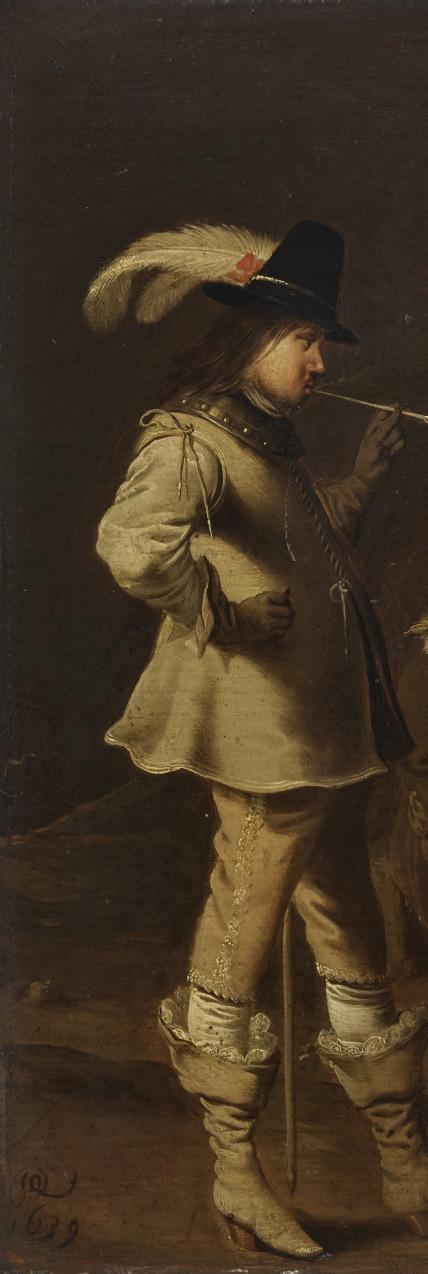

A moonlit river landscape with figures on the bank and a town beyond
signed in monogram 'AV DN' ('AV' and 'DN' linked, lower center) oil on panel
18º x 27Ω in. (46.4 x 70 cm.)
$40,000-60,000
PROVENANCE:
£31,000-45,000
€36,000-53,000
Étienne-Edmond Martin de Beurnonville (1825-1906), Baron de Beurnonville, Paris; his sale, Hôtel Drouot, Paris, 21 May 1883, lot 74.
with Terry-Engell Gallery, London, by 1961, where acquired by the following, Private collection, and by descent until, anonymously sold; Christie's, London, 11 July 2001, lot 35, where acquired by the present owner.
EXHIBITED:
London, Terry-Engell Gallery, The Netherlands in Landscape: Exhibition of Fine Paintings of the 17th-Century Dutch and Flemish Schools, 25 October-30 November 1961, no. 20.
LITERATURE:
C. Hofstede de Groot, Beschreibendes und kritisches Verzeichnis der Werke der hervorragendsten holländischen Maler des XVII. Jhts, VII, London, 1923, p. 413, no. 378. 'The Netherlands in Landscape at the Terry-Engell Gallery,' The Connoisseur, CXLVIII, 1961, p. 170, illustrated.
W. Schulz, Aert van der Neer, Doornspijk, 2002, p. 383, no. 1000.
By 1640, Aert van der Neer was established as a landscape painter, focusing on just a few subjects: winter scenes, snowstorms and nocturnes, particularly moonlit river scenes. This painting follows his characteristic approach to composing landscapes with a slightly elevated vantage point, a path stretching across the foreground populated with figures, far riverbanks dotted with architecture,and a river receding into the distance.Wolfgang Shulz lists thiswork among a number of similar moonlit landscapes and notes one copy of the present work (sold Anonymous sale, Rudolf Lepke, Berlin, 20 March 1900, lot 40). Van der Neer's mastery of reflected moonlight on the clouds, water and riverbanks, along with his use of a limited tonal palette of cool blues, browns, and a silvery white moonlight, give a sense of depth and convey the atmospheric effects of night falling.
This painting is first recorded in an 1883 sale of works belonging to the celebrated French collector Baron Étienne-Edmond Martin de Beurnonville (see Provenance). His collection included more than 1,000 paintings, drawings and sculpture, with works by Rembrandt van Rijn, Sir Peter Paul Rubens, Meindert Hobbema, and Salomon van Ruysdael, many of which are now in public collections.


Extensive Italianate landscape with a traveler and drovers on a road, a farmhouse and a village beyond
oil on canvas
24æ x 29 in. (62.8 x 73.7 cm.)
$70,000-100,000
PROVENANCE:
£53,000-75,000
€62,000-88,000
Charles T. D. Crews, Esq. (1839-1915), Portman Square, London, his deceased sale; Christie's, London, 1 July 1915, lot 5, for 60 gns., as J. and A. Both, to the following, with Agnews, London.
[The Property of a Family]; Christie's, London, 3 December 1997, lot 18, where acquired by the present owner.

EXHIBITED:
London, Royal Academy, Exhibition of Works by the Old Masters and by Deceased Masters of the British School, including a Collection of Water-Colour Drawings by Joseph M.W. Turner, Winter Exhibition, 1887, no. 81, as Jan and Andreas Both.
Leeds, Municipal Art Galleries, Loan Exhibition of Works by the Old Masters, 1889, no. 419, as Jan and Andreas Both. London, Guildhall, Exhibition of a Selection of Works by Early and Modern Painters of the Dutch School, 28 April-15 July 1903, no. 194, as Jan and Andreas Both.
Celebrated for his Italianate landscapes drenched in golden sunlight, Jan Both was an influential painter among the second generation of Dutch exponents of the genre. Jan and his older brother Andreas, with whom he often collaborated, studied at the Accademia di San Luca in Rome. They are documented as living on via Vittoria (a popular street for foreign artists) between 1630 and 1641. While in Italy, Jan was closely associated with the community of Northern painters known as the Bentvueghels, or ‘birds of a feather’. He also befriended the French painter, Claude Lorrain, with whom Both collaborated in Rome on a major project for the Spanish king Philip IV; a series of large landscapes to decorate his hunting lodge at the Buen Retiro in Madrid. While in Rome, Both specialized in genre subjects but on his return to his native Utrecht in 1642, he turned to the idealized landscapes for which he is best known. The present painting features among other identified works in an interior scene by the Flemish painter Gillis van Tillborch (fig. 1), dated circa 1660, testifying to Both’s popularity in his lifetime and beyond.
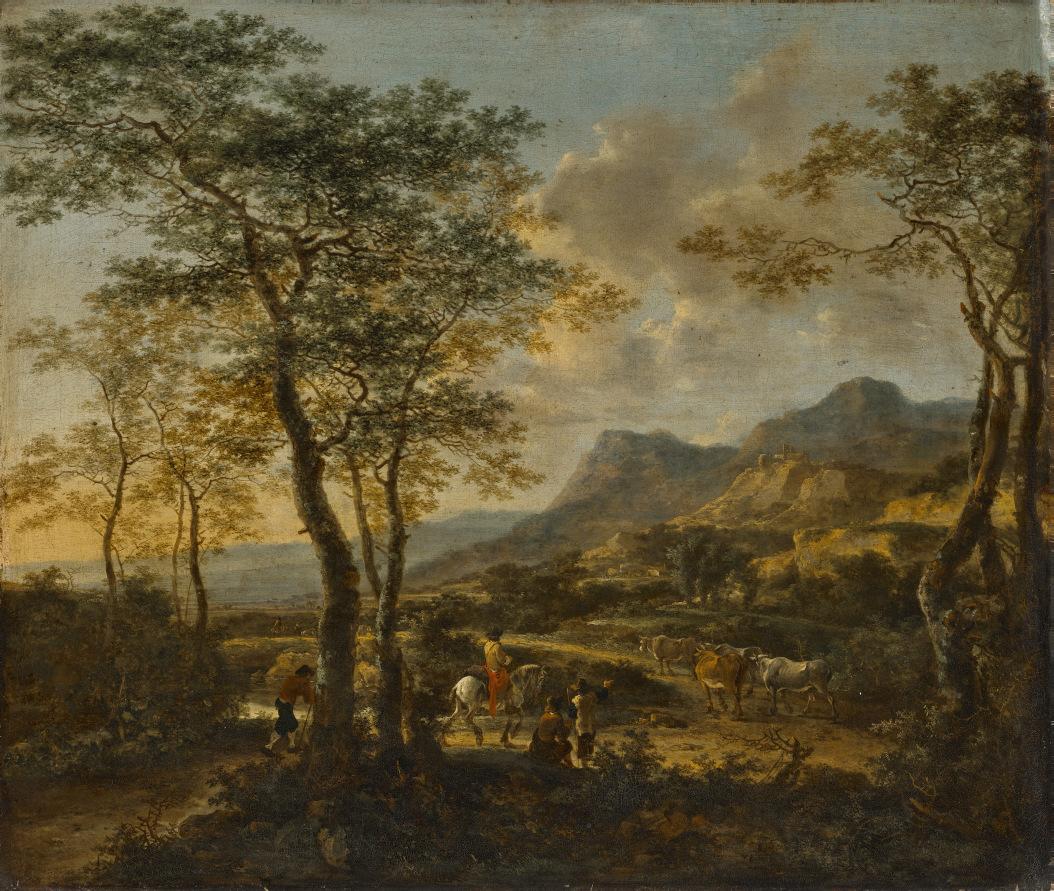
Fishermen displaying their catch on a rocky coast
oil on panel
15º x 22¡ in. (38.3 x 56.8 cm.)
$40,000-60,000
PROVENANCE:
£30,000-45,000
€36,000-53,000
Léon Gabriel Leduc, Marquis de Saint-Clou (1798-1873), Paris.
Thadée Joseph Antoine Hyacinthe van Saceghem (1767-1852), Ghent, by 1842; his sale, J. & A. Le Roy, Brussels, 2-3 June 1851, lot 85. [Property of a lady]; Christie’s, London, 13 December 1996, lot 9, where acquired by the present owner.
LITERATURE:
J. Smith, A Catalogue Raisonné of the Works of the Most Eminent Dutch, Flemish and French Painters, IX, London, 1842, p. 227, no. 257.
C. Hofstede de Groot, A Catalogue Raisonné of the works of the most eminent Dutch Painters of the Seventeenth Century, II, London, 1909, p. 581, no. 992.
B. Schumacher, Philips Wouwerman (1619-1668): The Horse Painter of the Golden Age, Doornspijk, 2006, I, p. 355, no. A465; II, pls. 74, 74b and 435 (incorrectly stating this painting was with Johnny van Haeften, London).
Birgit Schumacher proposed in her catalogue raisonné a dating of circa 1650-52 for this painting (loc. cit.), when the artist first succeeded, as Schumacher has noted, in ‘capturing convincing depth using an ideational diagonal’ (ibid., p. 65). Similarly, in this period Wouwerman’s figures became less dominant and the artist better integrated them within a landscape bathed in a diffuse, cool light. While Wouwerman still drew inspiration from other Haarlem artists, including Pieter van Laer and Isack van Ostade, by the late 1640s he had distinguished himself as an outstanding painter of horses, depicting them in complicated positions like that of the foreshortened dark horse seen from behind in the right foreground. Such intensely naturalistic qualities cannot be found in the works of his contemporaries.
French collectors in the eighteenth and nineteenth centuries voraciously acquired paintings by Wouwerman. This painting was formerly in the collection of the Marquis de Saint-Clou, which was dispersed in Paris sales in 1874, 1885 and 1889. The Marquis de Saint-Clou's collection included a multitude of seventeenth-century northern landscapes and contemporary French paintings. His collection of decorative arts was equally expansive; an eighteenth-century mantel clock from his collection is now in the J. Paul Getty Museum, Los Angeles (inv. no. 73.DB.78).


A peasant girl and boy driving a vegetable cart on a flooded track, with other peasants on their way to market and a boy herding cattle
signed, inscribed and dated 'J. siberechts · f · au anvers. 1671' (center, on the tug of the carriage) oil on canvas
27æ x 40Ω in. (70.5 x 102.9 cm.)
$40,000-60,000
PROVENANCE:
with Galerie P. Rosenthal, Berlin. with Galerie Sanct Lucas, Vienna. with Galerie Helbing, Munich.
Anonymous sale; Galerie Fievez, Brussels, 16 December 1929, lot 89. with Galerie de Heuvel, Brussels, by 1931.
£31,000-45,000
€36,000-53,000
Dr. Cornelis Johannes Karel van Aalst (1866-1939), Huis-te-Hoevelaken, Amersfoort, by 1933, and by descent to his son,
Dr. N.J. van Aalst, his sale; Christie's, London, 1 April 1960, lot 45 (6,500 gns. to Agnew).
Sir Jocelyn Edward Greville Stevens (1932-2014), London, [The Property of Jocelyn Stevens, Esq.]; Christie's, London, 2 July 1976, lot 74 (12,380 gns.). with Frost and Reed, London, by 1977.
Anonymous sale; Finarte, Milan, 3 December 1993, lot 85.
Anonymous sale; Christie's, London, 7 April 1995, lot 15, where acquired by the present owner.
EXHIBITED:
Dordrecht, Dordrechts Museum, Boom, Bloem en Plant: Nederlandse meesters uit vijf eeuwen, 16 July-31 August 1955, no 127.
LITERATURE:
T.H. Fokker, Jan Siberechts peintre du paysage flamand, Brussels and Paris, 1931, pp. 89-90. W.R. Valentiner, Dutch and Flemish Old Masters in the Collection of C.J.K. van Aalst, Verona, 1939, pl. viii.
A leading painter of bucolic landscapes, Jan Siberechts became a member of the Antwerp Guild of Saint Luke some time between 1648-49, and worked in his native city for nearly a quarter century before settling in England. As with many Dutch and Flemish artists in the seventeenth century, Siberechts was greatly inspired by the Roman campagna and suffused his early landscapes with Italianate light. While it is uncertain whether the artist traveled to Italy himself, he would have seen the work of his contemporaries–such as Nicolaes Berchem, Karel Dujardin, and Jan Both–and absorbed their observations on light and atmosphere. In the 1660s Siberechts developed his distinctive style of Flemish landscape painting that focus on the idylls of country life.
This painting, dated 1671, depicts a busy scene, focusing on a peasant girl and boy driving a cart laden with vegetables presumably on the way to market. Cows meander down the stream, herded along by a boy with his coat slung over his staff. The cart driver pauses to look over his shoulder at the cowherd and, farther downstream, another woman drives a cart while countryfolk wend their way along the path. Siberechts repeated the motif of figures fording a stream bordered by trees many times, and used this particular compositional structure of the boy and the cart in another painting from 1671, The Farm Cart, now in the National Gallery of Ireland in Dublin (fig. 1). In The Farm Cart, the boy is looking down at the animals leaning to drink from the stream. This backwards glance from the boy serves to quiet the bustle evident in both paintings, and the stillness of the moment is punctuated only by the horse relieving itself.


A forest floor still life with a bird's nest, toadstools, snails, boysenberries, aurora, and common blue butterflies
oil on panel
12¬ x 10¡ in. (32 x 26.4 cm.)
$50,000-70,000
PROVENANCE:
£38,000-53,000
€45,000-62,000
Anonymous sale; Christie's, London, 17 December 1999, lot 141, where acquired by the present owner.
The reverse of this painting bears an unidentified collector’s label, ascribing it to the Dutch still-life painter Rachel Ruysch. The attribution to Ruysch was dismissed by Fred G. Meijer when the work first appeared at auction in 1999 (see Provenance). Elias van den Broeck and Rachel Ruysch’s sotto bosco (‘forest floor’) still lifes have been confused on a number of occasions, as exemplified by another work by van den Broeck, now in the collection of the Ashmolean Museum, Oxford, to which Ruysch’s signature was added at a later date (fig. 1).Van den Broeck’s still lifes are known for their realism.Along with his contemporaries Otto Marseus van Schriek, Jeremias Falch and Philip van Kouwenbergh, van den Broeck went as far as attaching real butterfly wings to a white painted ground in order to best capture their beauty. In many cases, as in the present panel, the wings were subsequently lost and likely restored by another hand (see F. Meijer, 'Philip van Kouwenbergh', Oud Holland, LII, 1980, p. 320).


Un Bûveur sous une Treille (A Drinker under a Trellis)
oil on canvas
50√ x 38¿ in. (129.2 x 96.9 cm.)
$30,000-50,000
PROVENANCE:
Pastré collection, Brussels.
£23,000-37,000
€27,000-44,000
Comtesse Charles de Vogüé, Paris; her deceased sale, Palais Galliera, Paris, 14 March 1972, lot 182, as Nicolas de Largillierre and described as a self-portrait. Juan de Bestegui (1930-2017), Château de Groussay, his sale; Sotheby's and Poulain, on the premises, 2 June 1999, lot 409, where acquired by the present owner.
EXHIBITED:
Paris, Salon du Louvre, 1745, no. 116.
LITERATURE:
G. Huard in Les peintres francais du XVIIIe siècle', L. Dimier ed., Paris and Brussels, 1928, p. 265, no. 8, under lost works.
J. Collins, 'Genre paintings exhibited at the Salon, 1699-1789', The Age of Watteau, Chardin, and Fragonard. Masterpieces of French Genre Painting, C. Bailey, et al., ed., exhibition catalogue, New Haven and London, 2003, pp. 394 and 400.
G. de Wallens, Jacques François Delyen, peintre ordinaire du Roi (Gand, 1684-Paris, 1761) et les peintres belges actifs a Paris ai XVIIIe siècle, PhD dissertation, Leuven, 2005, pp. 112, 126, 222-223, 246, 400, 581, 589 and 631, no. 37, fig. 155.
G. de Wallens, Les peintres belges actifs à Paris au XVIIIe siècle à l'exemple de Jacques François Delyen, peintre ordinaire du roi (Gand, 1684-Paris, 1761), Brussels and Rome, 2010, pp. 205-207 and 533, no. 37, fig. 151.
Having trained under Nicolas Largillierre, Jacques-François Delyen was a regular exhibitor of portraits and, occasionally, genre scenes at the Salon between 1737 and 1747. Although this work was sold in 1977 as a self-portrait by Largillierre (loc. cit.), it was later recognized as an autograph work by Delyen by Gérard de Wallens, who published it as such first in his 2005 dissertation and again in his 2010 catalogue raisonné on the artist (loc. cit.). Exhibited at the Salon of 1745 by Delyen, the work was described as ‘Autre plus petit, représentant un Bûveur sous une Treille’ (Another small one, representing a Drinker under a Trellis).
De Wallens explored the sitter's identity, questioning whether it might be is Delyen himself. While acknowledging the possibility, he ultimately argued against it, noting that the painting was exhibited alongside another work explicitly described as a self-portrait. The sitter, who is dressed in typical attire for an artist of the time, may instead have been another artist or friend within Delyen’s circle.

signed and dated 'charles coypel 1732' (lower left)
oil on canvas
25¬ x 32 in. (65 x 81.2 cm)
$120,000-180,000
PROVENANCE:
Baron Linder, possibly Constantin Carlsson Linder (1836-1908).
Comte de Canson, Paris.
£90,000-130,000
€110,000-160,000
Galerie Jamarin, Paris, where acquired March 1954 by, Walter P. Chrysler, Jr. (1909-1988), Virginia; his deceased sale, Sotheby's New York, 1 June 1989, lot 97, where acquired by the present owner.
EXHIBITED:
New York, Finch College, 1963, no. 13.
Norfolk, VA, Chrysler Museum, on loan by February 1975. Raleigh, NC, North Carolina Museum of Art; Birmingham, AL, Birmingham Museum of Art, French Paintings from The Chrysler Museum, 31 May 1986-18 January 1987, no. 7. Nantes, Musée des Beaux-Arts, Le Théâtre des Passions, 11 February-22 May 2011, no. 35.
LITERATURE:
Mercure de France, December 1733, pp. 2879-2880 (cf. Slatkine Reprints, Geneva, 1968, t. XXV, p. 372)
J.B. de Boyer, Marquis d'Argens, Examen Critique des différentes Ecoles et Peinture, 1768, (Minkoff reprint, Geneva 1972), pp. 244-245.
F. Ingersoll-Smouse, 'Charles-Antoine Coypel', La Revue de l'Art ancien et moderne, 1920, p. 146.
I. Jamieson, Charles-Antoine Coypel, Premier Peintre de Louis XV et Auteur Dramatique (1694-1752), 1952, p. 83 (with reference to the engraving)
A. Schnapper, 'A propos de deux nouvelles acquisitions: 'Le chef-d'oeuvre d'un muet' ou la tentative de Charles Coypel', Revue de Louvre, 1968, no. 17, p. 254, note 3.
P. Rosenberg, Chardin: 1699-1779, Cleveland, 1979, pp. 288-289.
E. Zafran, 'Charles Antoine Coypel's Painting Ejecting Thalia', Apollo, April 1980, pp. 280287, pl. 1.
S. Taylor, 'Engravings within Engravings: Symbolic Contrast and Extension in some 18th Century French Prints,' Gazette des Beaux-Arts, 1985, p. 63.
C. Bailey, The first Painters of the King: French Royal Taste from Louis XIV to the Revolution, New York, 1985, p. 137, no. 111a.
J. Harrison, French Paintings from the Chrysler Museum, Norfolk, Virginia, 1986, pp. 12-14, 101, no. 7.
T. Lefrancois, Charles Coypel, Peintre du roi (1694-1752), Paris, 1994, pp. 257-260, no.140. Nantes, Musée des Beaux-Arts, Le Théâtre des passions, 1697-1759, Cléopâtre, Médée, Iphigénie, 11 February-22 May 2011, no. 35, pp. 142-143, illustrated in color.
J.-C. Castelain, 'Le théâtre féconde le grand genre', L'Oeil, DCXXXIV 2011, p. 64 illustrated in color.


Charles Coypel was a born into a revered dynasty of French painters, the son of Antoine Coypel (1661-1722), nephew of Noel-Nicolas Coypel (1690-1734) and grandson of Noel Coypel (1628-1707), history painters all. Something of a prodigy, he was accepted into the Académie Royale aged 21 with the submission of Jason and Medea (1715; Schloss Charlottenburg, Berlin), and achieved the highest levels of official success when he was appointed First Painter to the King and Director of the Académie in 1747. He was also a man of the theatre, a critic and author of some 40 plays–mostly three-act comedies and farces–which he regularly staged and directed, often casting himself in leading roles. In one of these plays, La Poesie et la Peinture (Allegory of Painting), an allegorical comedy, characters debated the virtues and failings of both arts.
The present painting–Coypel’s best-known and most extensively studied–is a witty allegory concerning his dual careers as painter and playwright. The painting depicts an artist’s studio that has been designed like a stage set and overflows with paintings, sculptures and a tumble of books, each of which makes reference to the then 40-yearold artist’s own life. Casts of ancient and Renaissance sculptures–the Farnese Hercules, Belvedere Torso, and Giambologna’s Architectura–attest to Coypel’s classical training at the Académie. His self-portrait gazes out at the viewer from the side wall. Two large paintings–a modello for Coypel’s tapestry cartoon of The Sacrifice of Iphigenia hanging on the back wall and a large landscape (featuring a helmeted Minerva) resting on an easel–are evidence of Coypel’s accomplishments as a painter. The jumbled still life of bound manuscripts in the foreground represents an array of Coypel’s plays, each bearing the title and date of production.
Atthebackoftheroomontherightstandsthepersonification of Painting holding a palette and paintbrushes and pointing her mahlstick threateningly at Thalia, Muse of Comedy,
whom she orders from the painter’s studio. As Thalia flees, her drapery whipping through the air, the Muse of Comedy turns to cast a final look upon Painting, and gathers in her skirts several volumes of plays that have been handed her by agitated putti.An angry génie running beside her, swaddled in leopard skin with a leopard skin toque, pulls a broken chain that had previously bound him. In the lower right corner of the painting is collaged a small scrap of paper on which, in Coypel’s own hand, is written a verse comparing Thalia to a mistress spurned: `Muse, I have had enough of your affair/ Leave, and take prose and poetry with you./ To turn one’s head/ Painting is quite enough'.
The painting had long been mistakenly interpreted as representing Coypel’s decision to abandon the theatre–his plays had not always been enthusiastically received–to devote himself to painting exclusively. However, a drawing of the subject in pen, ink and gouache (Bibliothèque Nationale, Paris) that is dated ‘1727’, five years before the painting was executed, was first employed by Coypel as the frontispiece of the Les Folies de Cardenio–the only one of his plays published in his lifetime–before he repurposed it as the design for the present canvas. Furthermore, as Eric Zafran noted in a seminal article (loc. cit.), Coypel continued to write plays after 1732, the year in which the painting is dated. Indeed, a close reading of the titles and dates inscribed on the bindings of the folios reveals that several plays postdate the painting, indicating that Coypel continued writing and continued revising his most inventive and original painting.
So enduring was the painting’s fame in 18th-century France that Chardin included Bernard Lépicié’s engraving after Painting Ejecting Thalia in the background of his own final genre scene, La Serinette (Lady with a Bird-Organ; 1753; The Frick Collection, New York), twenty years after the print’s publication.
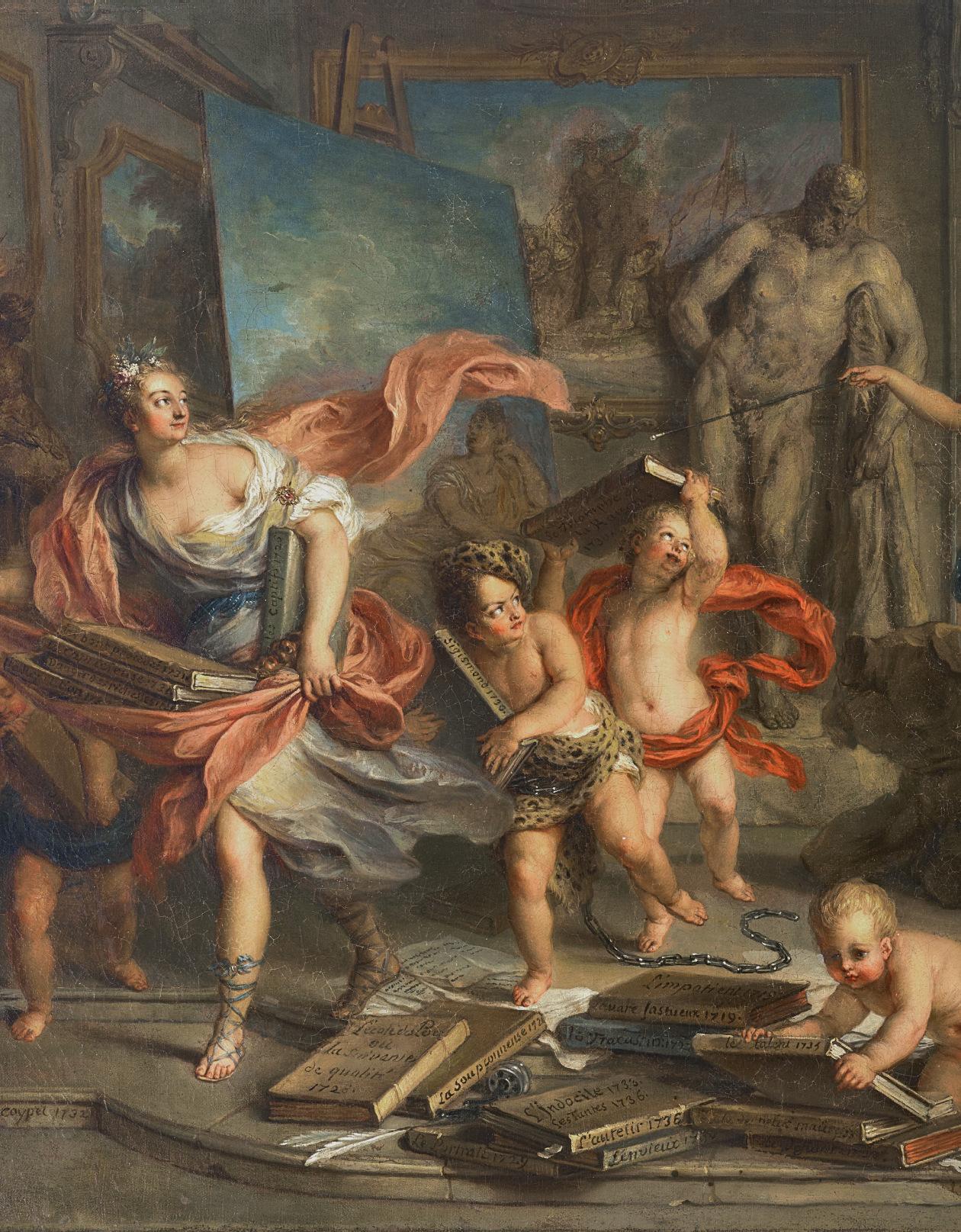
oil on canvas
29Ω x 25 in. (74.9 x 63.5 cm.)
$60,000-80,000
£46,000-60,000
€53,000-70,000
PROVENANCE: with Pietro Accorsi, Turin (according to a label on the reverse). [The Property of a Gentleman]; Sotheby's, London, 3 December 1997, lot 88, where acquired by the present owner.
Very little is known about Catherine Lusurier, who lived to be just 28 years old. She was the niece of Hubert Drouais (1699-1767), under whom she was apprenticed until his death. In his workshop she likely would have worked closely with Drouais’ son, Francois-Hubert Drouais (1727-1775), a leading portraitist of the time.The Drouais's stylistic influences are clearly seen in the present painting as well as her other works, primarily depicting portraits of children and artists. Although only a few signed paintings by Lusurier have survived – most notably the Portrait of Jean-Germain Drouais, the son of Francois-Hubert, now in the Musée du Louvre, Paris (fig. 1.; inv. no. 6406) – scholars such as Helen Ashmore have used these to reconstruct her small corpus of works (see H. Ashmore, 'Catherine Lusurier (1752-81): A woman painter in eighteenth-century Paris', Apollo, May 2001, pp. 34-40).

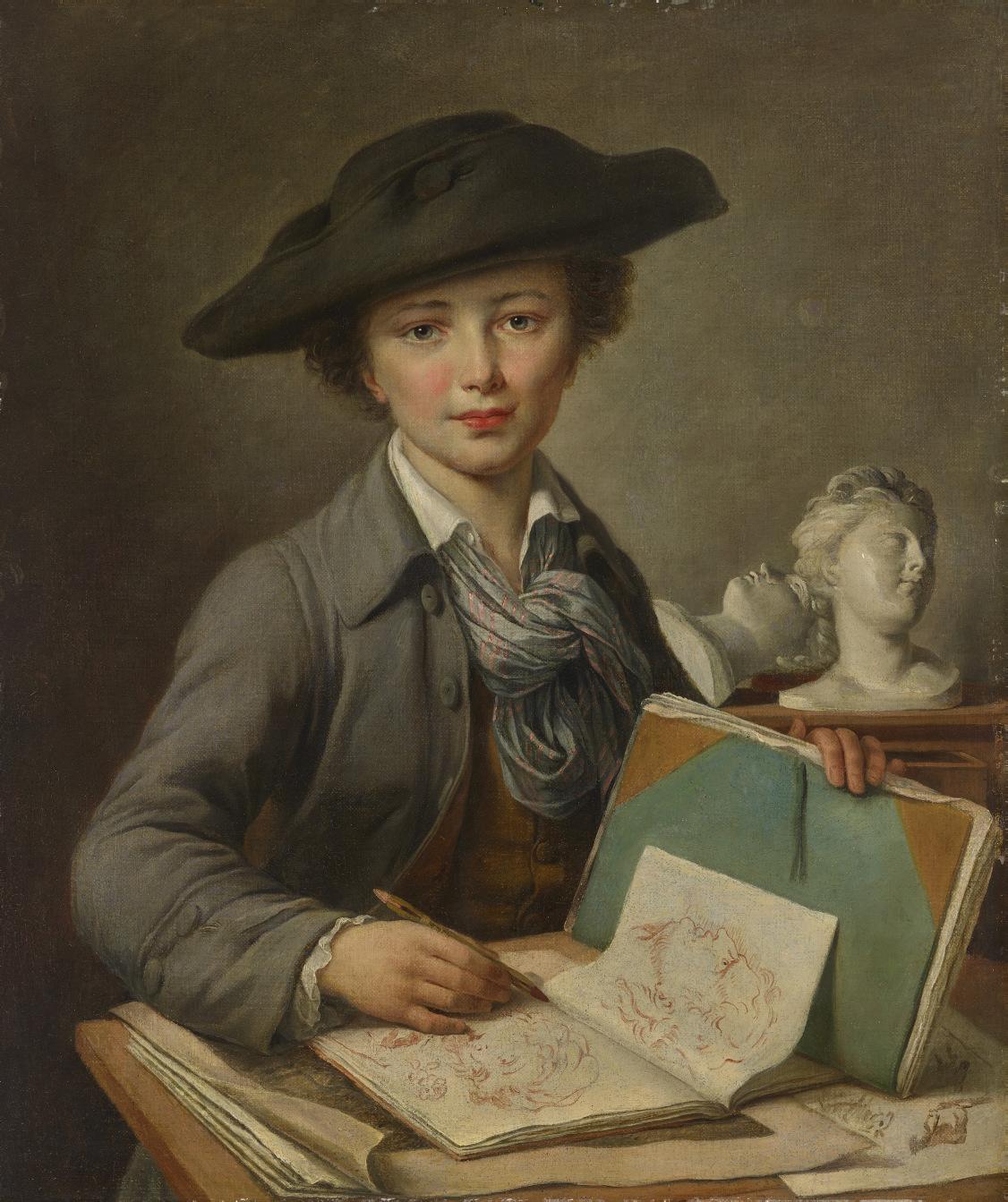
Banditti by a fountain with a statue of abundance, two pyramids beyond
oil on canvas
363 x 264 in. (92.3 x 67.2 cm.)
$80,000-120,000
PROVENANCE:
£61,000-90,000
€71,000-110,000
Conrad E. Thornquist (1907-1989), Spring Lake, Michigan; [Property from the Estate of Conrad E. Thornquist], Christie's, New York, 31 May 1989, lot 73A, where acquired by the present owner.
This atmospheric canvas, an early work from Robert’s Roman period, exemplifies the artist’s lifelong engagement with the decay of antiquity.The pyramids, though never seen by the artist in situ, reflect the 'Egyptomania' that flourished in mid18th-century Rome, where such motifs were accessible via ancient spoils and imperial imitations. Painted in the late 1750s, it reveals the formative influence of Giovanni Battista Piranesi's capricci and Giovan Paolo Panini's theatrical ruins, yet with a more poetic, light-infused sensibility. The classical statuary, silhouetted against the pyramids, evokes both grandeur and loss—an emblematic expression of Robert’s romantic vision of history.
Robert’s classical education at the Jesuit-run Collège de Navarre made him an able Latinist and kindled his fascination with the ancient world. But it was his 1754 journey to Rome in the entourage of the French Ambassador, the Comte de Stainville (later Duc de Choiseul), that immersed him in the ruins that became his lifelong obsession and earned him the sobriquet Robert des Ruines. During his eleven-year stay, he met Fragonard, Piranesi, and Panini, and was commissioned by the Abbé de Saint-Non to document antiquities—Egyptian, Greek, and Roman—for the Abbé’s influential guidebooks on Italy.
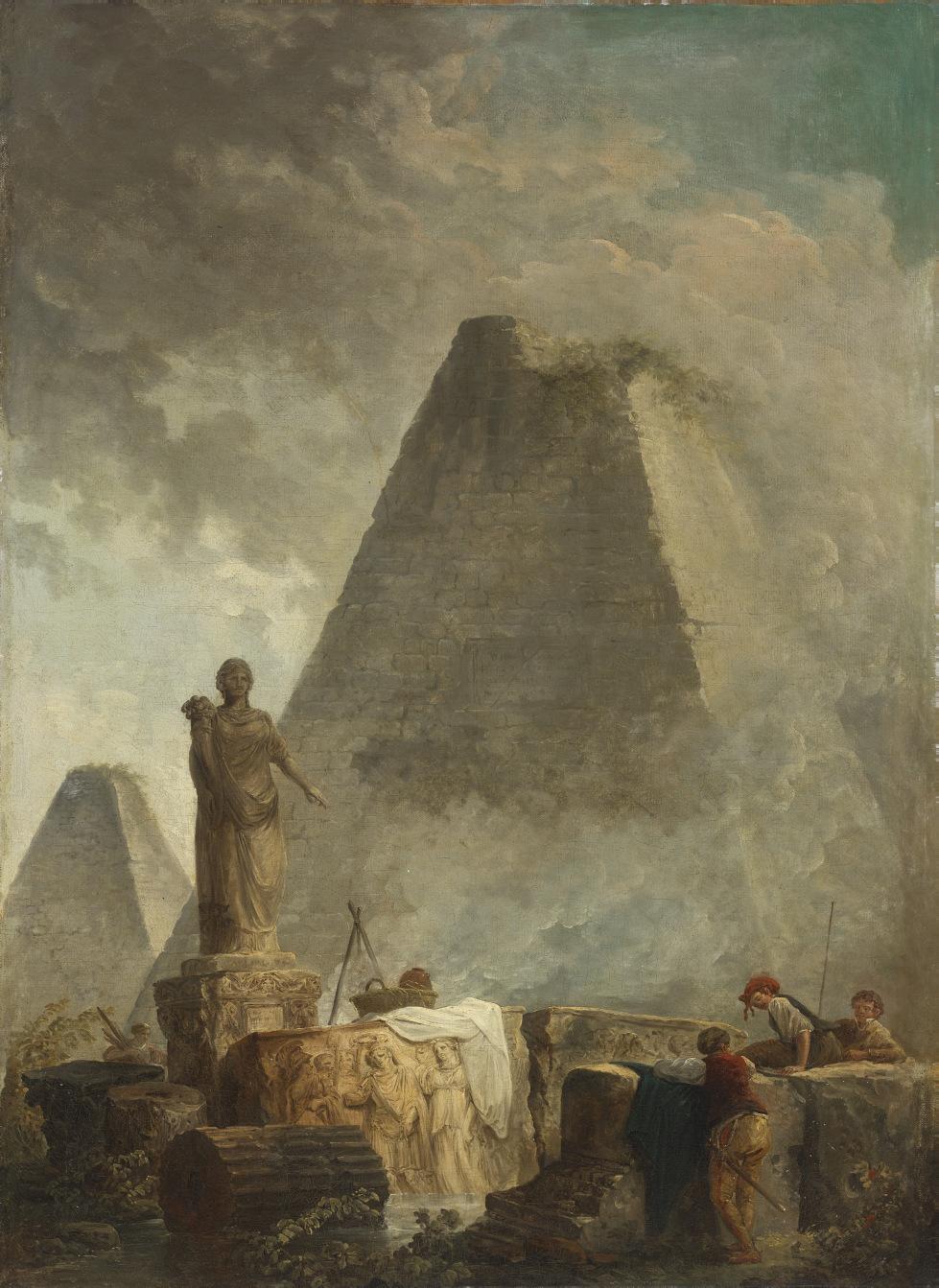
A portrait of Charles III, King of Spain (1716-1788), three-quarter length, wearing the insignia of the orders of the Holy Spirit, of St. Januarius and of the Golden Fleece
oil on canvas
57 x 43º in. (144.8 x 110 cm.)
$20,000-30,000
PROVENANCE:
£16,000-23,000
€18,000-26,000
Sotheby's Peel & Associates, Madrid, 18 May 1993, lot 1, as Attributed to Andrés Ginés de Aguirre, where acquired by the present owner.
This composition is copied from Marino Salvador Maella's Portrait of King Charles III, dated 1783, now in the Colección Banco de España, Madrid (inv. no. P_56). The likeness itself derives from Anton Mengs' official portrait, painted around 1767 and for which the king sat, now at the Prado Museum, Madrid (inv. no. P002200). The Prado painting was the source of the many copies and variants produced by Mengs, his workshop and followers. The present painting depicts the monarch in a red velvet waistcoat with gold embroidery, a departure from the armor seen in the Prado picture. When last sold in 1993, this painting was attributed to Andrés Ginés de Aguirre' (loc. cit.), who became Maella's assistant in 1785.

oil on canvas
6¡ x 9º in. (16.2 x 23.6 cm.)
$3,000-5,000
PROVENANCE:
£2,300-3,800
€2,700-4,400
Alexander Young (1828-1907), London; his sale, Christie's, London, 30 June-4 July 1910, lot 371, as 'J. Constable, R.A.', 65 gns. to the following, with Gooden & Fox, London.
Sir Kenneth Clark, 1st Baron Clark of Saltwood (1903-1983), Kent, and by descent until;
[The Property of a Gentleman]; Sotheby's, London, 10 July 1991, lot 83, as John Constable, R.A., where acquired by the present owner.
LITERATURE:
G. Reynolds, The Later Paintings and Drawings of John Constable, 1984, I, p. xv, no. 24.68, and II, p. 148, pl. 537, as John Constable.
Lionel Bicknell Constable was the seventh and last child of John Constable and his wife Maria. He was born in Hampstead in 1828 and, like his father, specialized in landscape painting. Leslie Parris and Ian Fleming-Williams' 1978 article highlights the closeness of the father and son's works, identifying a number of paintings whose attributions were confused, likely because Lionel often painted the same locations as his father (see 'Which Constable?', The Burlington Magazine, September 1978, pp. 566-578). The present cloud sketch does not particularly resemble the elder Constable's works in palette or technique; rather, it bears a much closer similarity to Lionel's cloud pictures. One example, now in the Yale Center for British Art, New Haven (inv. no. B1981.25.153) utilizes a similar chalky blue pigment and the paint is applied with comparably rapid, sweeping strokes. Later in life, Lionel turned away from painting in favor of photography, occasionally capturing the same landscapes his father had painted.


Portrait of a lady as Sappho, traditionally identified as Mademoiselle George
oil on canvas, unlined 46 x 35¬ in. (116.8 x 90.5 cm.) with inscription 'Bron Gerard / 1819' (on the reverse)
$60,000-80,000
PROVENANCE:
£46,000-60,000
€53,000-70,000
Maréchal Bugeaud, Château de Païssons (according to a label on the reverse). Dr. Antoine Chautereau (according to a label on the reverse). with Wildenstein & Co., by 1964, where acquired circa 1965 by, Private collection, and by whom sold, Anonymous sale; Sotheby's, New York, 24 January 2008, lot 94, as 'Circle of JacquesLouis David', where acquired by the present owner.
EXHIBITED:
San Francisco, M.H. De Young Memorial Museum, California Palace of the Legion of Honor, Man, Glory, Jest, and Riddle: A Survey of the Human Form through the Ages, 10 November 1964-3 January 1965, no. 185, as 'Baron Francois Gérard, Mlle. George.'
LITERATURE:
J. Mut i Arbós, 'Sappho Recalled to Life by Music', Music in Art, XLIII, Fall 2018, pp. 29 and 45, note 18, fig. 8, as 'François Gerard'.
This painting depicts a lady in the guise of the Greek poetess Sappho, seated nude on a couch, with a sheer white fabric delicately draped around her legs. She gazes upward with a longing expression, holding a tablet on which she has inscribed the name of her lover, Phaon. Behind her stands a small statue of Eros, the Greek god of love, and below the statue hangs a lyre, an object often associated with Sappho to symbolize her lyrical poetry and music. The subject of Sappho was frequently treated by Neoclassical painters, most famously by Jacques-Louis David for his Sappho and Phaon, commissioned by Prince Nikolai Yusupov in 1809, and now in the Hermitage Museum, St. Petersbug (inv. no. GE-5668). An old label affixed to the reverse of the present canvas identified the sitter as Mademoiselle George, the stage name of Marguerite George (1787-1867). George was one of the leading actresses of her time and one of Napoleon’s mistresses.
This work has previously been attributed to Baron François Pascal Simon Gérard, one of the most influential Neoclassical painters, and David’s most celebrated pupil. While the reverse of the painting bears an inscription with his name and is dated 1819, the stylistic elements—marked by fluid and expressive brushstrokes— do not reflect Gérard's work from this time. Accordingly, this compelling portrait was likely painted by another accomplished artist within his circle.

Portrait of William Hunt (c.1796-1854), Pittencrief House, Dunfermline, full-length, seated on a rock in a landscape with a dog
oil on canvas
78 x 53Ω in. (198.1 x 135.9 cm.)
$60,000-80,000
PROVENANCE:
£45,000-60,000
€53,000-70,000
The sitter's sister, Christina Harrowar, née Hunt, Inzievar, and by descent to, Mrs. James Macfarlane of Dunfermline, and by descent to, James Macfarlane of Dunfermline, Procurator-Fiscal for Fife, and by descent to, R.H.A. Hunt, Esq., Logie House, Dunfermline.
William Allan Coats (1853-1926), Dalskairth, Dumfrieshire, his deceased sale; Christie's, London, 10 June 1927, lot 122, as 'Portrait of James Harrower of Inzievar' (2600 gns. to Harcourt).
with M. Knoedler & Co., New York, where acquired in May 1974, by the following, Walter P. Chrysler Jr. (1909-1988), Norfolk; his deceased sale; Sotheby's, New York, 1 June 1989, lot 91, where acquired by the present owner.
EXHIBITED:
London, Gallery of the Royal Society of British Artists, Pictures and Drawings, Being the entire collection of the late W.A. Coats, Esq., January 1927, no. 139, identified as James Harrower of Inzievar.
Norfolk, The Chrysler Museum of Art, on loan, May 1974.
LITERATURE:
W. Armstrong, Sir Henry Raeburn, London and New York, 1901, p. 105.
Catalogue of the Collection of Pictures of the French, Dutch, British and Other Schools, belonging to W.A. Coats, Glasgow, 1904, unpaginated, pl. CXXIX, as a Portrait of James Harrower.
J. Greig, Sir Henry Raeburn, London, 1911, p. 49.
D. Sutton, 'Bright as New Sovereigns', Apollo, April 1978, pp. 240-241, fig. 1.
D. Mackie, Raeburn, Life and Art, Ph.D. dissertation, University of Edinburgh, 1993, III, pp. 545-546, under no. 412.
D. Thomas, The Art of Sir Henry Raeburn, exhibition catalogue, Edinburgh, 1997, p. 136, note 2, under no. 39.
The prime version of this portrait, which remains in the collection of the sitter's descendants, reveals changes to the sitter's pose. Increasing transparency of the paint, particularly in the landscape to the left of the sitter, exposes Raeburn's abandoned composition in which the sitter's proper left arm was outstretched and grasping a hunting rifle. Raeburn's final pictorial solution is repeated in the present painting, which descended in the family of William Hunt's sister, until the work entered the collection of William Alan Coats around the turn of the century.William Hunt was the elder son of William Hunt of Pittencreiff, an estate in Dunfermline. He succeeded his father in 1807, which may have spurred the commission for this portrait.

with monogram and with date 'Ao VII' oil on canvas
21¡ x 37æ in. (54.3 x 95.9 cm.)
$60,000-80,000
PROVENANCE:
£45,000-60,000
€53,000-70,000
with Knoedler Galleries, New York, by 1939. Anonymous sale; Christie's, New York, 31 January 1997, lot 103, as Anne-Louis Girodet-Trioson, where acquired by the present owner.
EXHIBITED:
New York, M. Knoedler and Company, Classics of the Nude: For the Benefit of the Lisa Day Nursery, 10-29 April 1939, no. 18, as Anne-Louis Girodet-Trioson.
This enigmatic painting, with its vaporous atmosphere, lyrical tonality, and erotic undercurrent, exemplifies the refined Neoclassicism that flourished in France at the close of the eighteenth century. In the wake of the Revolution, a new class of patrons, shaped by the era’s profound social upheavals, sought works of art that privileged imagination and emotional resonance over heroic grandeur.
The present composition invites comparison with Girodet’s Danäe of 1798 (Museum der bildenden Künste, Leipzig) and his decorations at the Château de Compiègne. Its delicate modelling and spatial ambiguity place it firmly within the tradition cultivated by artists in Girodet’s circle. As George Levitine observed in his seminal dissertation on the artist, such painters often employed the human form as a vehicle for expressing the sentiments of the soul, placing their figures in ethereal, dreamlike environments to heighten their otherworldly effect (G. Levitine, Girodet-Trioson: An Iconographical Study, Cambridge, 1978, p. 198).
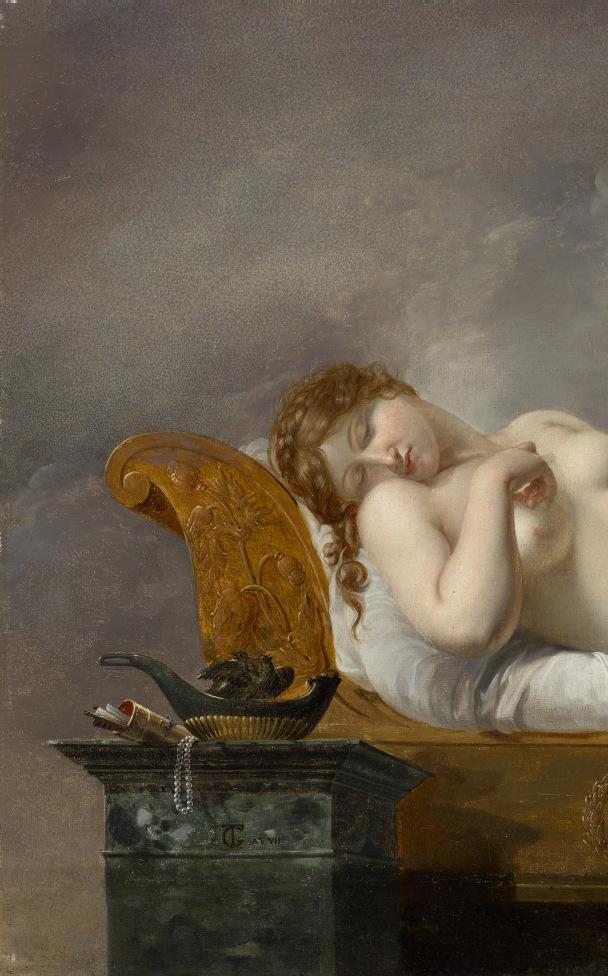

A trompe l'oeil of the back of a painting with a plaster medallion of Charity, an extensively inscribed label, an inventory number with red wax, and a spider
signed and dated 'E Hiernault 1766' (lower left, on the strainer) oil on canvas
22 x 28º in. (55.9 x 71.8 cm.)
$120,000-180,000
PROVENANCE:
£90,000-130,000
€110,000-160,000
Anonymous sale; Sotheby's, New York, 19 May 1994, lot 85, as a pair with lot 22, where acquired by the present owner.
EXHIBITED:
Washington, D.C., National Gallery of Art, Deceptions and illusions. Five centuries of trompe-l'oeil painting, 13 October 2002-2 March 2003, no. 90.
LITERATURE:
C.J. Welchman, Invisible Colors: A visual history of titles, New Haven, 1997, pp. 45-48, fig. 8a.
P. Conisbee, Deceptions and illusions. Five centuries of trompel'oeil painting, exhibition catalogue, Washington, D.C., 2002, pp. 313-315, no. 90, illustrated.
G. Alberti, Inganni dipinti. Trompe-l'oeil nella Fototeca Zeri, 2015, unpaginated, fig. 11.
Describingeveryinchofapainting’sreverse,thisfascinating still-life, along with its pendant lot 22, were the first works

by the artist Hiernault (or Yernault) to come to light. Since their appearance at auction thirty years ago, only one other painting–a trompe l’oeil letter board–bearing the artist’s signature has appeared on the art market at an auction in Boston (Grogan & Company, 2 March 2008, lot 566). Although nothing is known of the artist’s life, the varying spellings of the surname suggest that it could have been painted in Northern France, now Belgium,where this was common practice. Moreover, this type of trompel’oeil, representing the usually unseen reverse of a painting, has its roots in this region. Nearly a century before these works were painted, the Antwerp-based artist Cornelis Gijsbrechts painted The reverse of a framed painting, now in the Statens Museum for Kunst (fig. 1), providing an obvious prototype for Heirnault’s works. It is quite possible that Heirnault knew Gisbrechts’ painting, as the unknown artist similarly depicted inventory numbers on a small slip of paper affixed to the canvases with red wax.
Unlike Gijsbrects’ model, which is relatively void of extraneous details, for this painting and its pendant, Hiernault delightfully chose to include unusual clues that relate additional information. The extensively inscribed label on the painting with a bookplate featuring Noah (lot 22) tells us the story of the painting's imaginary recto, noting that it depicts the creation of the universe and all the animals, as well of that of its mate (lot 22) which represents the Fall of Man and Cain and Abel as one continuous narrative. The label also tells a tale about discovery of these paintings–stating that they were found at the foot of Mount Ararat, deep in the forest, and that the two works may have hung in the lavish galleries of the Seraglio in Constantinople alongside other curiosities including a box of matches used by Abraham to light the fire for the would-be sacrifice of his son Isaac.The label on the painting with a plaster medallion of Charity recounts a seeminglyunrelated storyof a sultana taken to the Seraglio by a guardian appointed by Mohammed. The bookplate, featuring Noah and Hebrew letters, relates to the story of Creation purportedly featured on the painting’s recto. It remains unclear, however, how the medallion of Charity fits into this puzzling group of symbols.

A trompe l'oeil of the back of a painting with an extensively inscribed label, hanging cords, an inventory number with red wax, and a Hebrew bookplate
signed and dated 'E. Yernault 1766' (lower left, on the strainer) oil on canvas
21√ x 28º in. (55.6 x 71.8 cm.)
$120,000-180,000
PROVENANCE:
£90,000-130,000
€110,000-160,000
Anonymous sale; Sotheby's, New York, 19 May 1994, lot 85, as a pair with lot 21, where acquired by the present owner.
EXHIBITED:
Washington, D.C., National Gallery of Art, Deceptions and illusions. Five centuries of trompe-l'oeil painting, 13 October 2002 - 2 March 2003, no. 91.
LITERATURE:
C.J. Welchman, Invisible Colors, New Haven, 1997, pp. 45-48, fig. 8b.
P. Conisbee, Deceptions and illusions. Five centuries of trompe-l'oeil painting, exhibition catalogue, Washington, D.C., 2002, pp. 313-315, no. 91.
G. Alberti, Inganni dipinti. Trompe-l'oeil nella Fototeca Zeri, 2015, unpaginated, fig. 10.
For more on this painting, please see lot 21.
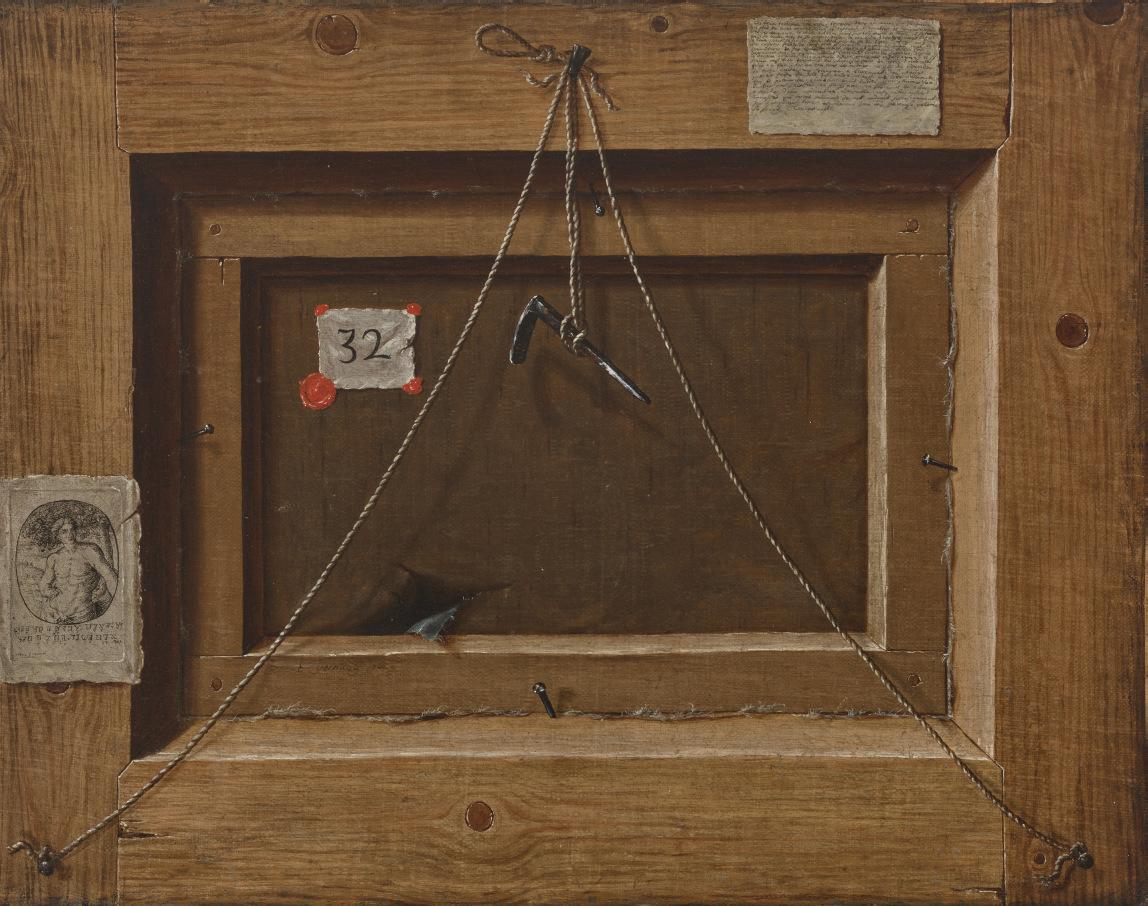
A pair of still lifes depicting prosthetic arms, prosthetic legs, and medical instruments in a trompe l'oeil framed niche
oil on canvas, unframed
110Ω x 43Ω in. (280.7 x 110.5 cm.), each a pair (2)
$80,000-120,000
PROVENANCE:
£60,000-90,000
€71,000-110,000
Anonymous sale; Sotheby's, Monaco, 18 June 1992, lot 76, as French School, circa 1853, where acquired by the present owner.
These large trompe l’œil panels depict a striking array of prosthetic arms and legs, braces, and various apparatuses essential for wearing these items. Their scale and painted arched frames suggest that they may have been designed as faux display cases or doors, possibly within a store specializing in such equipment.
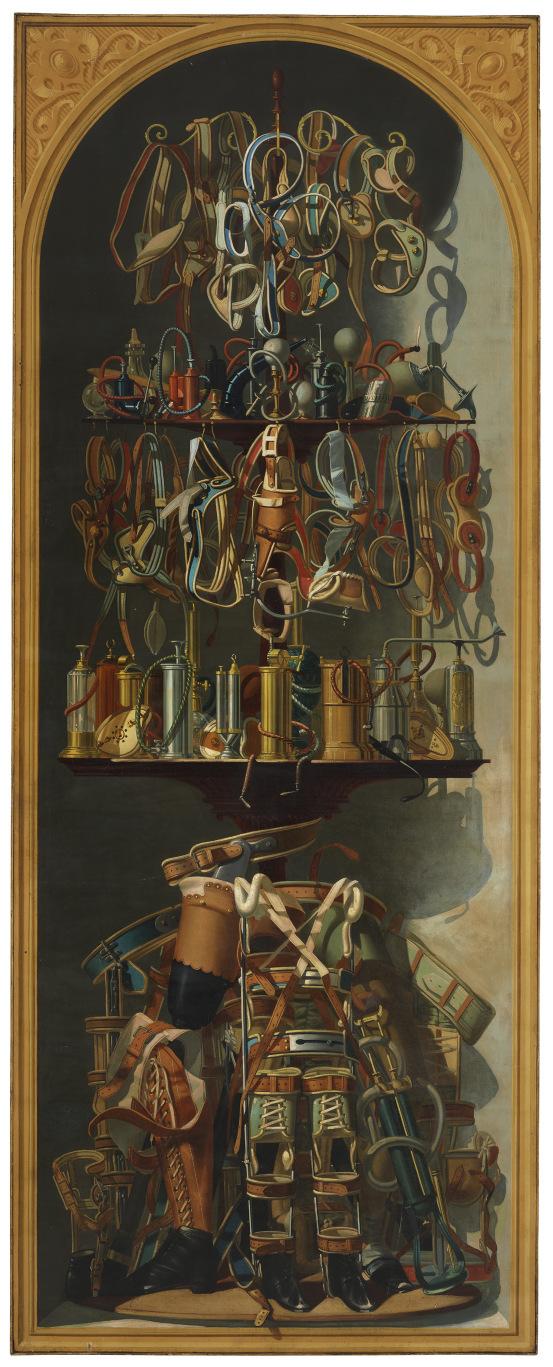
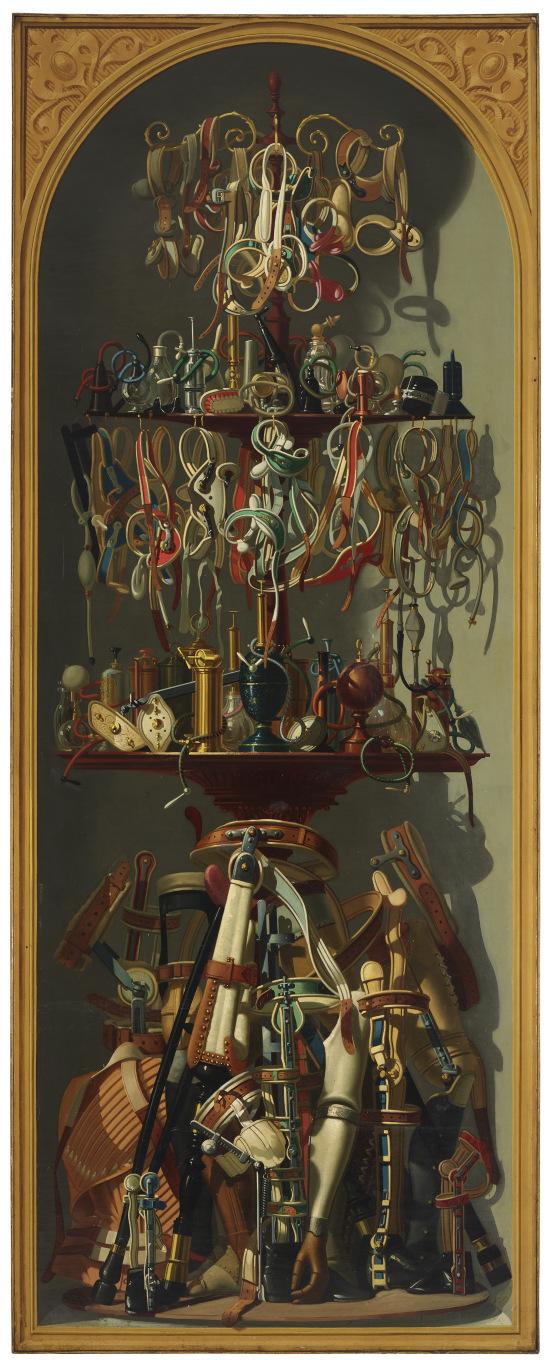
A landscape with women gathering chestnuts
signed 'Joph Bidault' (lower right, strengthened) and dated '1800' (lower left) oil on canvas, unlined
19¿ x 15æ in. (48.6 x 40 cm.)
$50,000-70,000
PROVENANCE:
£38,000-53,000
€44,000-62,000
Anonymous sale; Sotheby's, Monaco, 19 June 1994, lot 530, where acquired by the present owner.
We are grateful to Stéphane Rouvet for endorsing the attribution of this work on the basis of photographs. The painting will be included in his forthcoming catalogue raisonné on the artist (private communication, April 2025).

Architectural Study
Painted circa 1820s-1830s. oil on canvas
12¡ x 15¬ in. (31.5 x 39.8 cm.)
$8,000-12,000
PROVENANCE:
Anonymous sale; Sotheby's, London, 13 May 1994, lot 111. Acquired at the above sale by the present owner.
£6,000-9,000
€7,100-11,000
The present work was painted by Louis-Jacques-Mandé Daguerre, inventor of the daguerreotype. Though now best-known as one of the fathers of photography, Daguerre was also a Romantic painter and printmaker, most famous before his invention as the proprietor of the Diorama, a popular Parisian spectacle featuring theatrical painting and lighting effects. Daguerre had begun his experiments in the 1820s as a way to fix the fleeting image of the camera obscura permanently to a surface, but was not able to do so reliably until 1838–he presented his invention to the Académie des Sciences in January of 1839.
This work dates from approximately the same period of his career and is one of only a small number of surviving paintings by the artist–the majority of his painted work was destroyed in a fire shortly before his death. According to the sale catalogue when the work was sold in 1994, the work formerly bore a label on the reverse of Alphonse Giroux, Daguerre’s camera maker.


Napoleon with his Troops
signed and dated 'EDOUARD DETAILLE./1907.' (lower right)
watercolor on paper
25¡ x 16¿ in. (64.4 x 41 cm.)
$7,000-10,000
PROVENANCE:
Wallace C. Yost, Florida. His sale; Sotheby's, New York, 22 February 1989, lot 85. Acquired at the above sale by the present owner.
EXHIBITED:
£5,300-7,500
€6,200-8,800
Pensacola, Pensacola Museum of Art, The Napoleon Collection of Wallace C. Yost, 6 June - 10 July 1987; also Maitland, Maitland Art Center, 5 December 1987-17 January 1988, no. 7, as Napoleon I Standing with His Troops
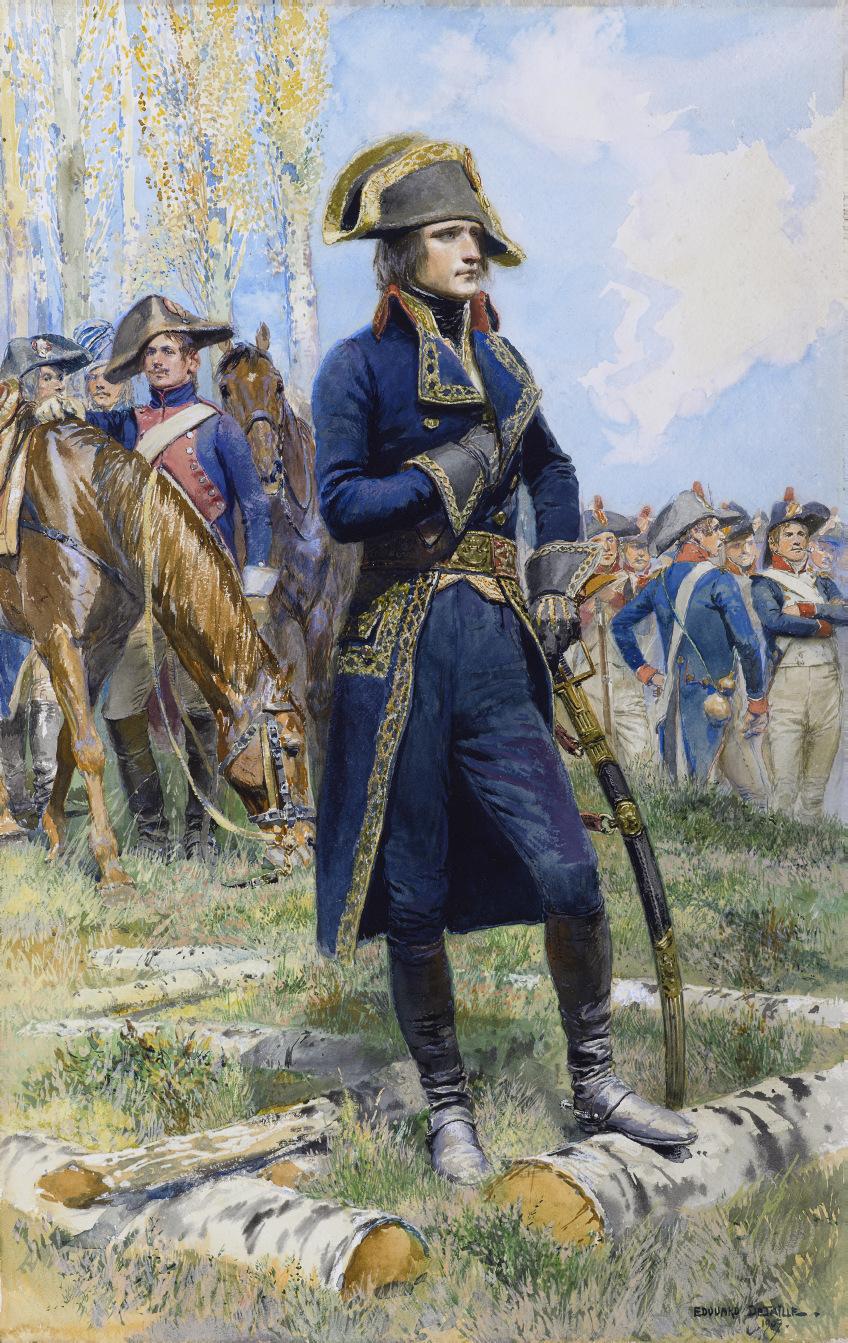
View of the Seine, Rouen Beyond
signed 'Paul. Huet.' (lower right) oil on canvas
9¿ x 14Ω in. (23.3 x 36.8 cm.)
Painted between 1826 and 1828.
$15,000-20,000
£12,000-15,000
€14,000-18,000
PROVENANCE: (possibly) P. E. Dromont. (possibly) His sale; Hôtel Drouot, Paris, 4 December 1871, lot 19, as Bords de Seine, près Rouen (Étude).
Anonymous sale; Sotheby's, New York, 8 May 1998, lot 16. Acquired at the above sale by the present owner.

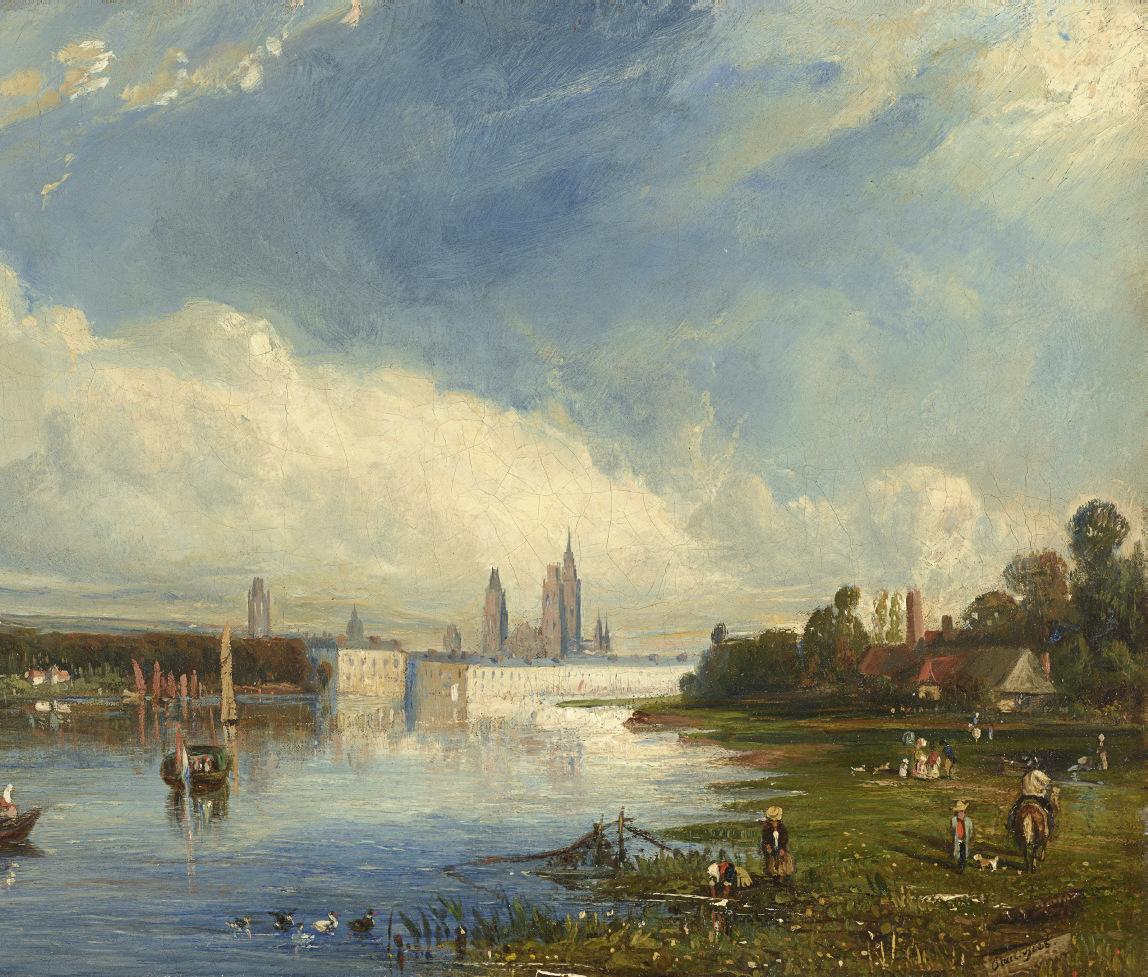
signed and dated 'Gv. Doré 1870' (lower right) black chalk, charcoal, pen and brown ink, wash, watercolor and gouache on paper on board 29Ω x 39º in. (75 x 99.7 cm.)
$50,000-70,000
PROVENANCE:
The artist.
His sale; Hôtel Drouot, Paris, 22 May 1875, lot 17. Private collection, Hamburg, before 1900. Private collection, France.
£38,000-52,000
€44,000-61,000
Anonymous sale; Christie's, Paris, 10 April 2008, lot 191. Acquired at the above sale by the present owner.
EXHIBITED:
Strasbourg, Musée d'Art Moderne, Gustave Doré, 1832-1883, 10 June-31 August 1983; also Paris, Musée Carnavalet, 10 September-6 November 1983, no. 2, illustrated.
LITERATURE:
R. Delorme, Gustave Doré, peintre, sculpteur, dessinateur et graveur, Paris, 1879, pp. 45, 48, illustrated with a print.
B. Jerrold, Life of Gustave Doré with one hundred and thirtyeight illustrations from original drawings by Doré, London, 1891, pp. 292, 408.
L. Dézé, Gustave Doré. Bibliographie et catalogue complet de l'oeuvre, Paris, 1930, pp. 14, 86.
J. Valmy-Baysse, L'Art et la vie, Gustave Doré, Paris, 1930, pp. between 204-205, 318, illustrated with a print.
K. Farner, Gustave Doré, der industrialisierte Romantiker, Dresden, 1963, p. 267, no. 230, illustrated, erroneously catalogued as an oil painting.
J. Damase, Gustave Doré, peintre et sculpteur, Paris, 1979, no. 67, illustrated.
A. Renonciat, La vie et l'oeuvre de Gustave Doré, Paris, 1983, pp. 206-207, illustrated erroneously catalogued as an oil painting.
E. Zafran, R. Rosenblum and L. Small, Fantasy and Faith, The Art of Gustave Doré, New Haven and London, 2007, pp. 36-40, illustrated with a colored version of the print.
The Franco-Prussian War, initially an attempt by the Second French Empire to reassert its dominance over continental Europe against the Northern German Confederation, would ultimately end in tragedy for the French, with the capture of Napoleon III, the horrors of the Siege of Paris and the Commune, and the fall of the Second Empire. However, at the start of the war, French confidence and nationalist spirit were high. In Gustave Doré’s La Marseillaise, the artist captures France's wartime spirit, enthusiasm and triumphalism during these early days of the conflict. La Marseillaise, from which the drawing takes its name, was declared the anthem of the First Republic in 1795, and was originally entitled Chant de guerre pour l'Armée du Rhin. This title would have had particular resonance during the
Franco-Prussian War when the French army was again referring to itself as The Army of the Rhine as they marched on the Prussian Rhineland.
The drawing depicts a personification of Liberté, or perhaps France, wearing a Phrygian cap, raising a sword aloft in one hand and a flag in the other, leading a crowd of armed soldiers and volunteers toward what is surely a battlefield. By depicting her with her mouth open and her eyes skyward, Doré seems to suggest she is leading the crowd in singing La Marseillaise as they march. Though the song had been officially banned by Napoleon III, the war led to a resurgence in its popularity, and Doré apparently planned to create a drawing illustrating each verse of the song. The present drawing possibly relates to the sixth verse, in which liberty is exhorted to fight alongside her defenders.
The political passion and fervor of this moment were such that Doré canceled a long-planned trip to London in order to stay close to his compatriots at home. Though he already knew the horrors of war firsthand, Doré was extremely patriotic and, as Blanchard Jerrold described, ‘seized his pencil, and it became a weapon in his hands by which he stimulated the ardor of his countrymen’ (B. Jerrold, Life of Gustave Doré with one hundred and thirtyeight illustrations from original drawings by Doré, London, 1891, p. 291). The inspiration for the central figure in Doré’s drawing was undoubtedly Delacroix's famous La Liberté guidant le peuple (Louvre, 1830) but he was also inspired by François Rude's sculptural decoration for the Arc de Triomphe in Paris, also called La Marseillaise. During the war years, Doré repeated this same central personification, sometimes winged and sometimes not, almost obsessively in other compositions with a strong patriotic content, known mainly through lithographs and other drawings.
See, for example, the sheet in the Cleveland Museum of Art entitled Liberty, which depicts her striding out of the open gate of a prison over the body of a fallen king while breaking chains, the drawing France, Mounted on a Hippogriff, Leads her Children to the Aid of Paris, in Strasbourg, and Le Chant du départ, in which she is holding a torch aloft, current location unknown.
As the German army closed in in Paris and throughout the Siege, Doré continued to draw, becoming one of l'année terrible’s most faithful chroniclers. Afterwards, like many other artists, Doré left France for a time, despondent over the surrendering of his beloved Alsace to the Germans. He finally made his delayed trip to London, and would continue on to Scotland, where he would produce some of his most magnificent and celebrated landscapes, far from the horrors he had seen in the streets of Paris only a few years before.
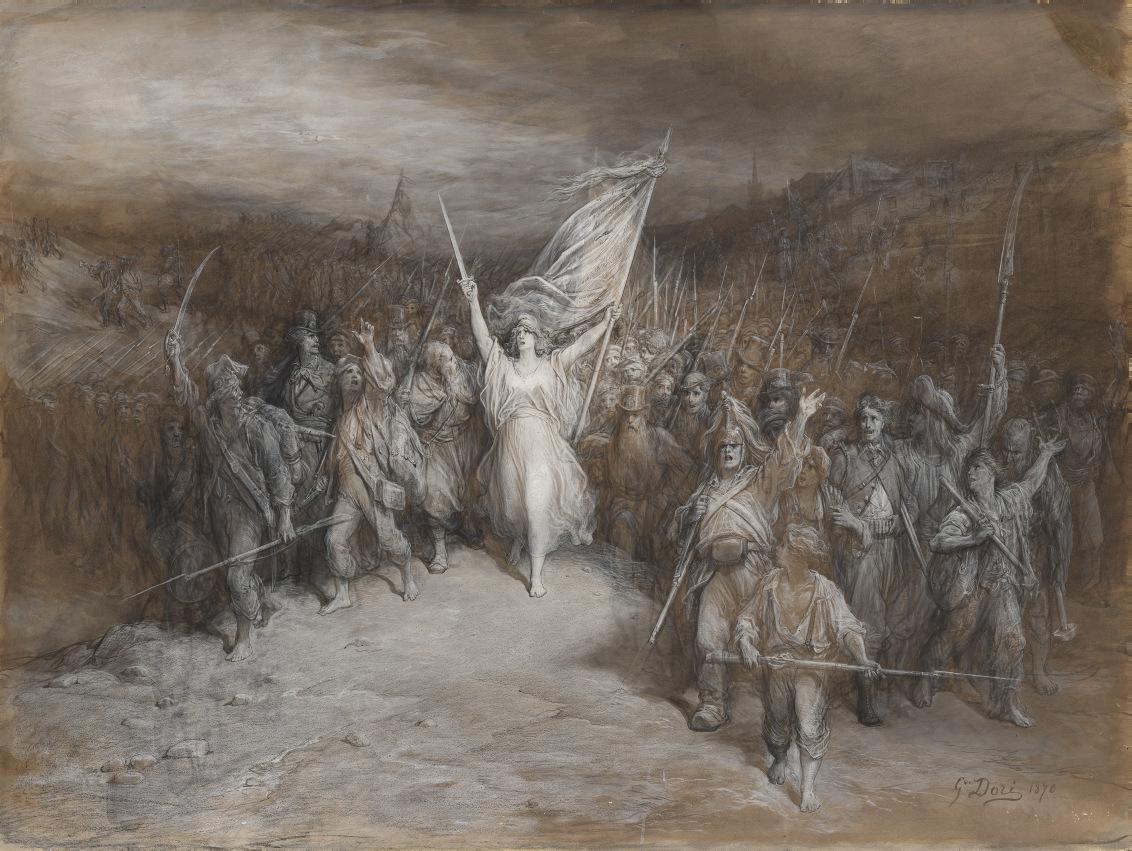
oil on canvas
24 x 18æ in. (61 x 48 cm.)
$5,000-7,000
PROVENANCE:
Eugenie Josephson, Stockholm, by at least 1942.
£3,800-5,200
€4,400-6,100
Anonymous sale; Beijers Auktioner, Stockholm, 6 November 1990, lot 134, as Den helige Anastasius with Kriströms Konstbyrå.
Acquired directly from the above by the present owner, 20 August 1993.
EXHIBITED:
Stockholm, Galerie St. Lucas, Ernst Josephson, Malningar ur privata samlingar, 1942, p. 25, no. 30, as Sankt Anastasius.
LITERATURE:
E. Blomberg, Ernst Josephsons Konst, Stockholm, 1956, p. 74, as S:t. Anastasius
I. Mesterton Ingrid et al., Ernst Josephson (1851-1906), Bilder und Zeichnungen, exh. cat., Bonn and Bochum, 1979, n.p. biography under 1874.
B. Anderberg, E. Blomberg, et al., Ernst Josephson, exh. cat., Ordrupgaard, 2000, p. 95, under no. 7, as Den hellige Anastasius
The present work, probably painted in 1874, is a copy after Rembrandt's painting of the same title preserved in the National Museum, Stockholm. During his first trip to Paris, in 1874, Josephson made copies of the great masters in the Louvre including Rembrandt, Rubens, Frans Hals and Velázquez, with Rembrandt seeming to hold a particular preoccupation for the artist. This same year, he traveled to Stockholm and would again turn to the great Dutch master. Winning an Academy prize in 1876 enabled Josephson to make another trip; after stopping in Copenhagen and Paris, Josephson went to Antwerp and Amsterdam where he worked again on copies after Rembrandt. Interested primarily in chiaroscuro, he made copies of Rembrandt’s self-portrait of 1629, The Night Watch, and Syndics of the Drapers’ Guild. 'For Josephson this was not simply imitation but careful preparation for the purpose of creating works with the same rich, fulltoned spirit of humanity as the classical masters themselves' (E. Blomberg, Ernst Josephson, Painter, Poet, Precursor, exh. cat., Portland, OR, 1964-1965, p. 10). In 1877, Josephson painted a second copy of the Holy Anastasius which is now also conserved in the National Museum, Stockholm.

dated and signed with the artist's initial '1812. E.' (lower right) oil on canvas
31√ x 25¬ in. (80.7 x 65.1 cm.)
$15,000-25,000
PROVENANCE:
£12,000-19,000
€14,000-22,000
The widow of the consul J. Schierbeck (possibly Frederikke Sophie Schierbeck [18221899]), Helsingør, by 1898.
Anonymous sale; Christie's, London, Scandinavian Pictures, Drawings, Prints and Sculpture, 16 March 1989, lot 47.
Acquired at the above sale by the present owner.
EXHIBITED: Copenhagen, 1914.
LITERATURE:
E. Hannover, Maleren C. W. Eckersberg, Copenhagen, 1898, pp. 71, 327, fig. 36, no. 118, illustrated, as Etude af et fruentimmer.

signed 'R. Zünd' (lower left) oil on canvas
30æ x 41º in. (78.1 x 104.8 cm.)
Possibly painted circa 1859.
$100,000-150,000
PROVENANCE:
£75,000-110,000
€88,000-130,000
with Fritz Nathan, St. Gallen. Anonymous sale; Sotheby's, Zürich, 11 December 1997, lot 141. Acquired at the above sale by the present owner.
EXHIBITED:
Lucerne, Kunstmuseum Luzern, Robert Zünd, 12 June-26 September 2004, pp. 35, 115, unnumbered. Berlin, Deutsches Historisches Museum, Unter Baümen. Die Deutschen und der Wald, 2 December 2011-4 March 2012, pp. 140, 290, no. 36.
LITERATURE:
P. Fischer and C. Lichtin, eds., Swiss Masters: Publication for the 75-Year Jubilee of the Bernhard Eglin Foundation, Lucerne, 2008, pp. 75, 83.
Over the course of his long career, Robert Zünd returned repeatedly to the theme of the Eichwald (Oak Forest), and the works from this series are the most important in his œuvre. The artist wrote, ‘Meine einzige Seligkeit besteht darin, malen zu können, die schöne Natur, die ich so herzlich liebe, nachahmen zu können‘ (‘My only joy lies in being able to paint, to imitate the beautiful nature that I love so dearly') and his extraordinary eye for the most minute details of nature and his ability to portray them exactly are on full display in the present work. Almost photographic in its level of detail and abruptly cropped in the way a photograph might be, Zünd’s extraordinary composition represents a starkly modern approach to landscape painting in the mid-19th century.
Born in Lucerne, Zünd moved to Geneva in 1848, where he studied under two of the most important Swiss landscape painters of the 19th century, François Diday and Alexandre
Calame. The Swiss poet Gottfried Keller encountered Zünd’s work early in his career and described his landscapes as idealen Reallandschaft–ideal real landscapes. Zünd’s art was a perfect synthesis of contemporary styles, blending a highly polished Academic technique and idealism with a Romantic approach to the forest–both a quiet refuge and an inherently wild place. Zünd’s Eichwald feels at once closed in and imposing with the towering old growth trees continuing off into the distance and obscuring the horizon, and yet also peaceful and calm, with the shaft of sunlight descending to illuminate the beautifully delineated plants covering the forest floor before the viewer. Eichwald is one of only a few works by the artist not to include staffage, allowing the viewer to stand in awe of nature without the mediation of a painted human figure.
Eichwald is considered Zünd’s most significant work. A larger version of this same composition, painted in 1882, was acquired by the Kunsthaus Zürich in 1883, and is perhaps the artist’s best-known painting. Another version of the same size as the present work, dated in pencil on the stretcher to 1859 (around the same year as the present work is thought to have been painted), is in the collection of the Kunstmuseum Lucerne. The three paintings hung together at the Zünd exhibition in Lucerne in 2017 and such is the exactness of Zünd’s work that the details of these compositions are barely distinguishable from one another. Oils from this part of Zünd’s œuvre rarely appear on the market, and the appearance of the present work at auction is certainly noteworthy.
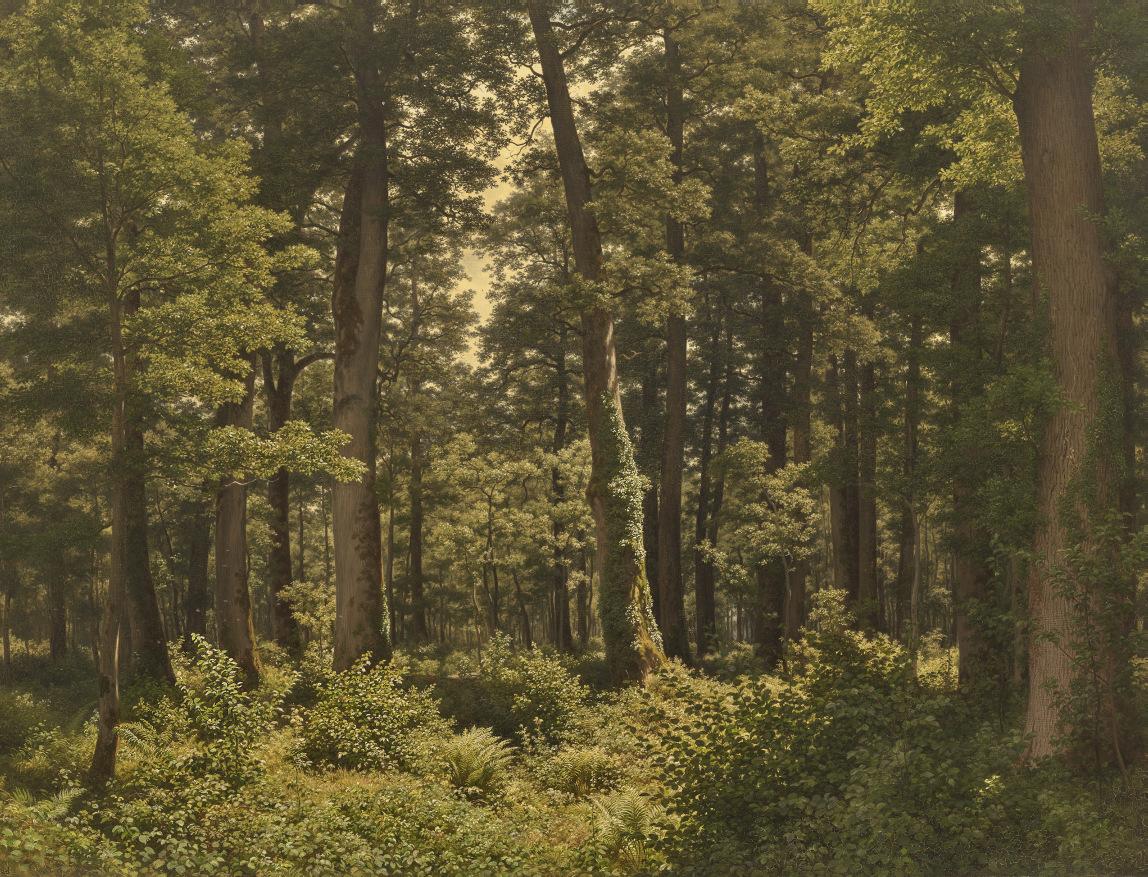
Vårløsning (Spring Thaw)
signed 'Balke' (lower right) oil on canvas
49¿ x 37º in (124.8 x 94.6 cm.)
$80,000-120,000
PROVENANCE:
The artist.
£60,000-90,000
€71,000-110,000
By descent through his family. Anonymous sale; Blomqvist, Oslo, 9 June 2009, lot 67. Acquired at the above sale by the present owner.
Peder Balke is one of the most innovative and original artists within the distinguished group of artists who have come to define 19th-century Scandinavian painting as we know it today. Part of the first generation of Norwegian painters following in the footsteps of J. C. Dahl, Balke’s paintings straddle Romanticism and Modernism in a way no other artist did, leading to critical rejection during his lifetime and his art being largely forgotten until its rediscovery in the 20th century. Today, we recognize in Balke’s sublime landscapes a truly unique voice, rendering the dramatic landscape of northern Norway not topographically, but emotionally. Balke’s singular anti-academic technique, which at times reduced elements of his compositions to almost total abstraction, redoubled the effect of nature’s majesty, rendering the experience of standing in the landscape for the viewer more than just depicting it.
In this, Balke was following in the footsteps of Caspar David Friedrich, who exhorted artists that they should not paint what they saw before them, but instead what they saw within themselves. ‘A landscape painting should be more than a record of external reality; it should portray the soul in an otherworldly dimension’ (W. Hoffman, 2010, quoted in K. Ljøgodt, in Quest of the Sublime, Peder Balke and the Romantic Discovery of the North, 2014-2015, p. 46). The 19th century was the time of the great polar expeditions, so it is perhaps no surprise that landscape painters, particularly those from Scandinavia, turned to their native landscape for inspiration in their work. Friedrich too was captivated by the idea of the polar regions, and his Sea of Ice (Kunsthalle, Hamburg, 1823-1824) was owned by Dahl, Balke’s friend and teacher.
Balke was one of the few artists painting scenes inspired by the polar north who had actually ventured north of the arctic circle firsthand, in fact he set a record for how far north he traveled. On a visit to Finnmark in Norway, the northernmost point of Continental Europe, in 1832, Balke found the landscape motifs to which he would return for the rest of his career. His paintings are infused with magical light inspired by his experience of the midnight sun there. The power and dramatic quality of his compositions reflect his first-hand experience of extreme weather conditions which he described as, ‘an impression that not only took hold of me in the intoxication of the moment, but even had a decisive influence on my whole future life... for in these northern regions it is the natural beauties that play the leading role, while the living children of nature, the people, occupy only a subordinate position to them’ (translated from D. Buchhardt, Peder Balke. Ein Pionier der Moderne, exh. cat., Krems and Copenhagen, 2008-2009, p. 10).
The present work certainly owes a debt to Friedrich, particularly works like his Spruce Thicket in the Snow (1827-28, Neue Pinakothek, Munich), Northern Landscape, Spring (circa 1825, National Gallery of Art,Washington) and his Winter Landscape (1811, Staatliches Museum Schwerin). Friedrich was one of the first artists to portray winter landscapes as stark and still, in which ‘no man has yet set his foot,’ as Hermann Beenken described. Balke’s painting, whose title translates to Spring Thaw, shows a winter landscape dominated by tall conifers at center with water just beginning to course through a creek after a long winter, its banks still coated in ice. The painting is suffused with a wonderful blue glow which suggests the polar dusk, and the hazy quality nearer to ground level gives the slightest sense of a mist created by the warmer air temperature interacting with the snowy ground. The unusual washes of light brown paint applied behind the central trees suggests a light source, perhaps the moon, there, a startlingly experimental technique typical of Balke. The snow-covered rocks in the foreground and some of the trees in the background at center become abstract in the notational way in which they are painted. As ever, Balke captures the essence of the scene–the rushing water, the haunting empty beauty, and the hazy atmosphere closing in on the viewer–as it feels above all else.

Paysanne en chemin
signed with the artist's initials 'TH.R.' (lower right) oil on panel
4√ x 7Ω in. (12.1 x 19.1 cm.)
Painted circa 1848-1850.
$12,000-18,000
PROVENANCE:
£9,100-14,000
€11,000-16,000
(possibly) Louis François Alfred Perrin de Bénévent (1824-1882) and Caroline Claudine Juliette Perrin de Bénévent, née Coumert (1831-1892), Lyon, after 1851.
Anonymous sale; Christie's, London, 18 February 1983, lot 148, as A Wooded Landscape with a Peasant on a Path.
Anonymous sale; Sotheby's, London, 19 June 1991, lot 138, as A Peasant in the Forest of Fontainebleau.
Acquired at the above sale by the present owner.
LITERATURE:
M. Schulman, Théodore Rousseau, catalogue raisonné de l’oeuvre peint, Paris, 1999, p. 204, no. 323, illustrated.


Sonnige Au (Sunny Meadow)
signed 'R. Zünd' (lower left) oil on canvas
30¡ x 20Ω in. (76.5 x 52 cm.)
$25,000-35,000
PROVENANCE:
£19,000-26,000
€22,000-31,000
Private collection, Switzerland. Their sale; Le Salon Romand, Zurich, 14 March 1918, lot 141, as Baumlandschaft Anonymous sale; Sotheby's, Zurich, 5 June 1996, lot 72. Acquired at the above sale by the present owner.
For a note on the artist, please see lot 31.

Landscape near Lippe at sunset
signed and dated 'Dahl/1827' (lower right) oil on canvas
5æ x 8¿ in. (14.3 x 20.5 cm.)
$18,000-25,000
PROVENANCE:
Private collection, Finland, circa 1960.
£14,000-19,000
€16,000-22,000
Anonymous sale; Sotheby's, London, 19 November 1997, lot 53. Acquired at the above sale by the present owner.
The present composition relates to a drawing entitled A Road Through the Fields listed in M. Lødrup Bang, Johan Christian Dahl, 1788-1857, Life and Works, Arlöv, 1987, II, p. 189, no. 565; illustrated, III, pl. 234.


Fra Skagen, hvor Skagerak og Kattegat mødes på Grenen (From Skagen, where Skagerak and Kattegat meet at Grenen)
signed, inscribed and dated 'Holger Drachmann Skagen Septbr 1906' (lower left)
oil on canvasboard
12æ x 21Ω in. (32.4 x 54.6 cm.)
$10,000-15,000
PROVENANCE:
£7,600-11,000
€8,800-13,000
Anonymous sale; Bruun Ramussen, Copenhagen, 23 February 1999, lot 127. Acquired at the above sale by the present owner.


Den Flygande Holändaren (The Flying Dutchman)
signed 'Ernst Josephson' (lower right) oil on board
4¡ x 8¿ in. (11.1 x 20.7 cm.)
$2,000-3,000
PROVENANCE:
Helga Smith, before 1959. Anonymous sale; Bukowskis, Stockholm, 29 May 1996, lot 72. Acquired at the above sale by the present owner.
LITERATURE:
£1,600-2,300
€1,800-2,600
E. Blomberg, Ernst Josephsons konst. Fran Näcken till Gaslisa, Stockholm, 1959, pp. 102-104, illustrated.
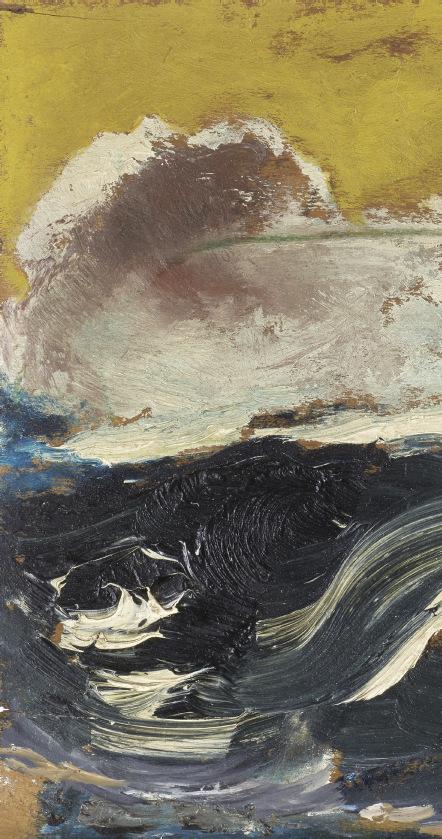

signed, dated and inscribed 'August Str-g. 92/Dalarö.' (on the reverse) oil on paper
3Ω x 7º in. (8.9 x 18.4 cm.)
$50,000-70,000
PROVENANCE:
£38,000-52,000
€44,000-61,000
Private collection, since 1900. Anonymous sale; Bukowski's, Stockholm, 25 November 1998, lot 215. Acquired at the above sale by the present owner.
EXHIBITED:
Stockholm, Prins Eugens Waldemarsudde, Landscapes, 4 March-11 April 1977, no 89.
Stockholm, Bukowski's Auktioner, Strindberg at Bukowski's, 2 May-6 May 2012.
London, Tate Modern, August Strindberg, Painter, Photographer, Writer, London, 2005, pp. 74, 153, no. 50, illustrated.
August Strindberg travelled to Dalarö in the Stockholm archipelago in May 1892, staying through the summer. In the midst of his divorce from his first wife Siri von Essen, Strindberg found his finances strained, and he lived chaotically during this period, which significantly affected his literary production. Instead, he found himself inspired by the landscape, and painted some 30 pictures during this time, his first serious return to painting since some youthful attempts in the 1870s. The first paintings he did during his sojourn were small and painted on whatever material he could find to hand, including book covers and cardboard. The motifs are inspired by the sea and the landscape of the archipelago but filtered through the lens of Strindberg's own endlessly creative mind. At the end of May he wrote to his friend and colleague Richard Bergh, 'I have a few paintings to show you which I painted from imagination. I have invented a new style which I have named 'Skogssnufvism'. It is based on spontaneity, to paint nature not as it is but to paint nature as a process of creation.'
The present work is a smaller variation of the work illustrated in G. Söderström, Strindbergs måleri, Malmö 1972, p. 105, pl. V. The theme of a flower or flowers on a beach is a recurring one for the artist during this period.

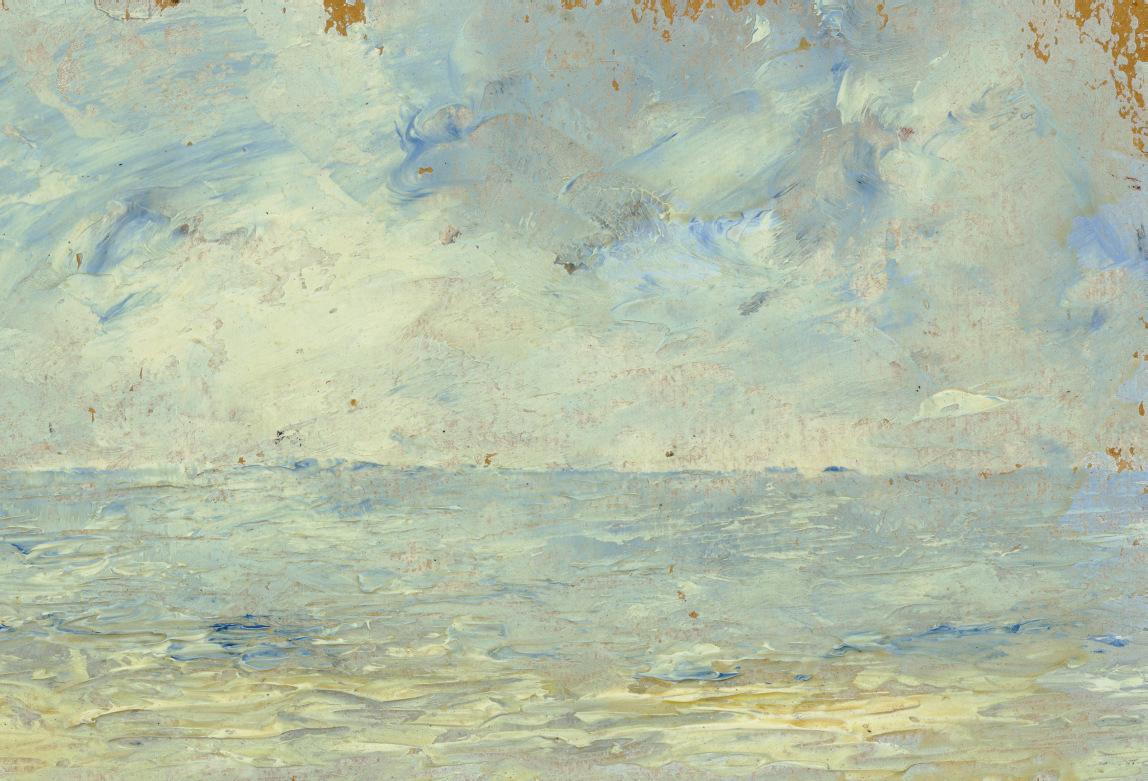
Ljudbojen (Sounding Buoy)
signed, dated and inscribed 'August Str-g 92/Dalrö' (on reverse) oil on paper
3¡ x 2¬ in. (8.2 x 6 cm.)
$25,000-35,000
PROVENANCE:
Ernst Josephson (1851–1906), Stockholm. Oscar Jacobsson, Stockholm. Gelly Neumann, Stockholm.
Mads-Peter Neumann (b. 1939), Skagen.
£19,000-26,000
€22,000-31,000
Anonymous sale; Bukowskis, Stockholm, 25-28 April 1989, lot 250, as Ljudbojen Acquired at the above sale by the present owner.
EXHIBITED:
London, Tate Modern, August Strindberg, Painter, Photographer, Writer, 17 February-15 May 2005, pp. 20, 153, no. 9, illustrated.
LITERATURE:
G. Söderström, Strindbergs maleri, Malmö 1972, pp. 98, 104, 223, 231 335, no. 21, pl. 9, illustrated.
Like lot 38, the present work was painted during the spring and summer of 1892, when Strindberg was staying in Dalarö. He was entirely focused on capturing the landscape, and his paintings are largely sky and water, with the occasional buoy or lighthouse thrown in as his inspiration dictated. During this time, the artist painted the sea on calm days as well as in full storm, reflecting both sides of his own turbulent personality during this difficult time.

Mindegabet mellem Karrebæk Fjord og Smålandshavet (Mindegabet between Karrebæk Fjord and the Sea of Småland)
signed 'L. A. Ring' (lower right) oil on panel
7Ω x 135 in. (19.1 x 34.5 cm.)
$10,000-15,000
PROVENANCE:
£7,600-11,000
€8,800-13,000
Anonymous sale; Bruun Rasmussen, Copenhagen, 1 December 1998, lot 255. Acquired at the above sale by the present owner.
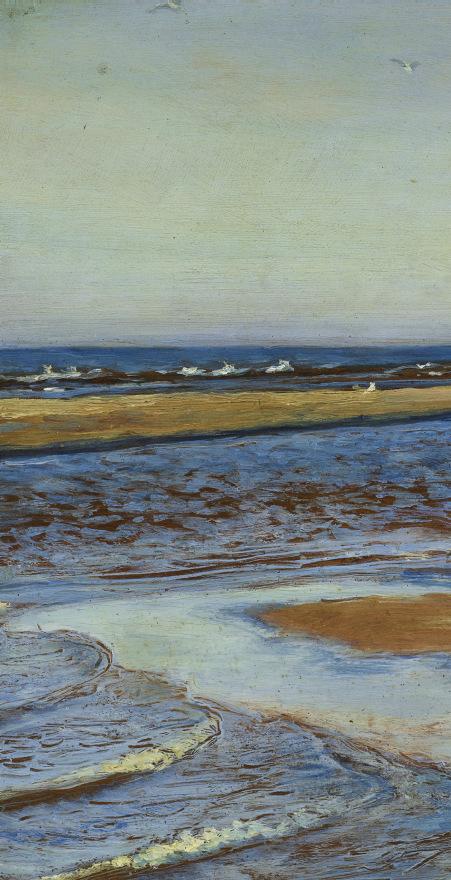
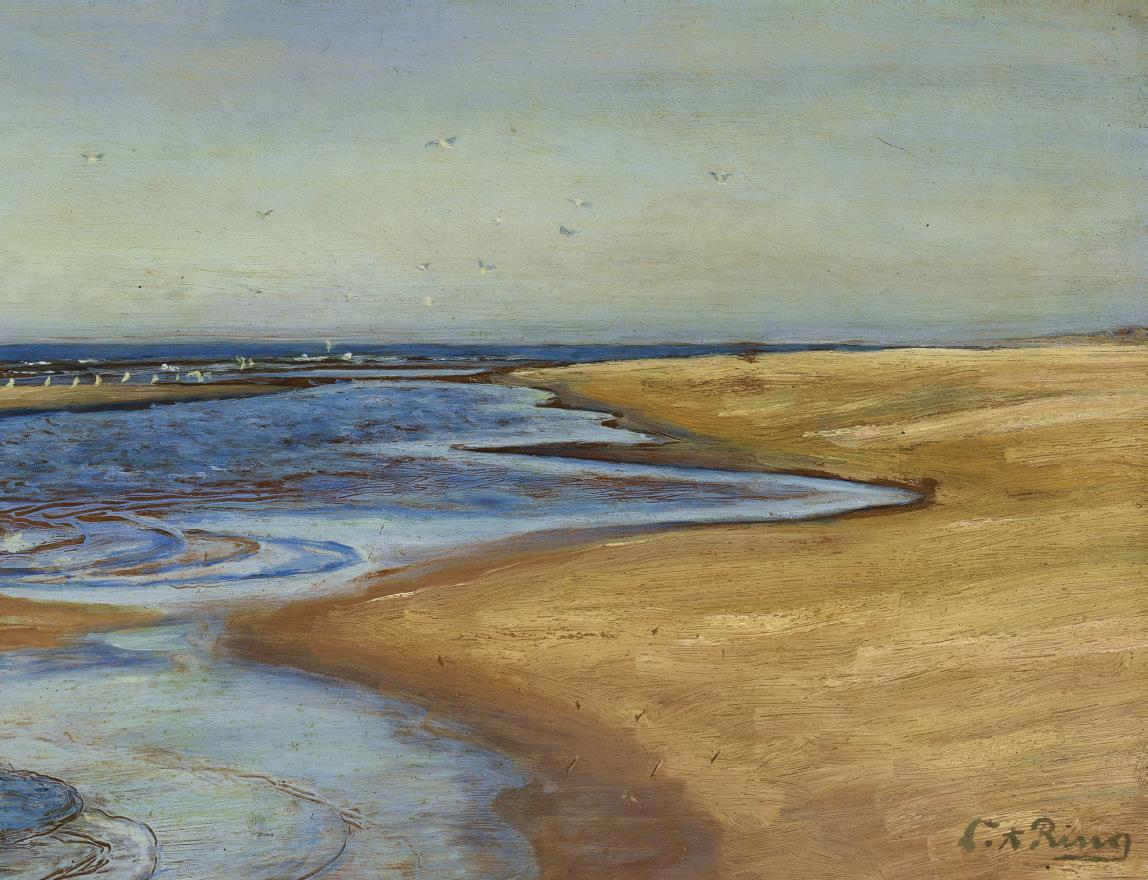
Roger's Slide, Lake George, New York
oil on panel
7 x 9√ in. (17.8 x 25.1 cm.)
$2,000-3,000
PROVENANCE:
£1,500-2,200
€1,800-2,600
James Sprent Virtue, Esq. (1829-1892), Oatlands Park and London. His sale; Christie's, London, 1 March 1879, lot 99. Volker (?), acquired at the above sale.
Anonymous sale; Sotheby's, London, 12 July 1995, lot 105 (as a pair with lot 42).
Acquired at the above sale by the present owner.
Thomas Creswick, R.A. was an English landscape painter and illustrator, and one of the best-known members of the Birmingham School of landscape painters. Though this work and lot 42 depict Lake George in upstate New York, Creswick nevervisited the United States.Instead,he based these paintings on either a drawing or print by the English topographical artist William Henry Bartlett, who first traveled to America in 1836 in the company of the American writer Nathaniel Parker Willis. Beginning in 1837, British publisher George Virtue began to publish Bartlett’s illustrations with text by Willis, entitled American Scenery: or Land, Lake, and River Illustrations of Transatlantic Nature. The book and its prints were first issued in a series of parts running to November 1839, and then the entire work was issued in two volumes in January 1840. Both the book and Bartlett’s prints were a huge success. American Scenery was reissued numerous times up to about 1870 and the prints (and pirated copies of them) appeared not only in these volumes, but also in magazines, other books, and as separate prints, illustrating their popularity.


Black Mountain, Lake George, New York
oil on panel
6¬ x 9√ in. (16.8 x 24.9 cm.)
$2,000-3,000
PROVENANCE:
£1,500-2,200
€1,800-2,600
James Sprent Virtue, Esq. (1829-1892), Oatlands Park and London. His sale; Christie's, London, 1 March 1879, lot 98. Volker (?), acquired at the above sale. (probably) Anonymous sale, Phillips, Ipswich, 6 November 1986, lot 294, as Black Mountain Lake George Anonymous sale; Sotheby's, London, 12 July 1995, lot 105 (as a pair with lot 41).
Acquired at the above sale by the present owner.
For a note on this artist, please see lot 41.
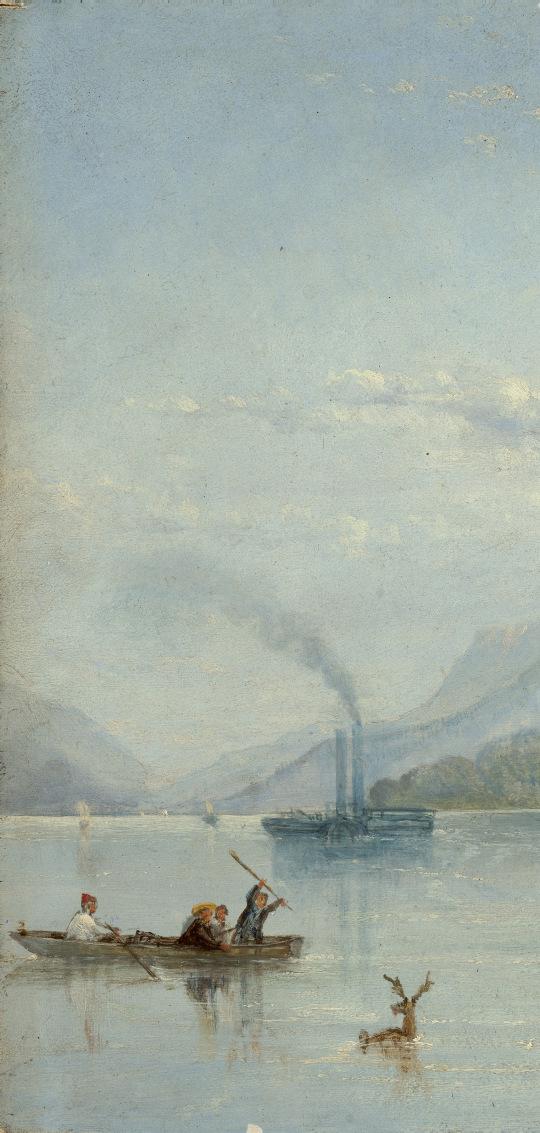
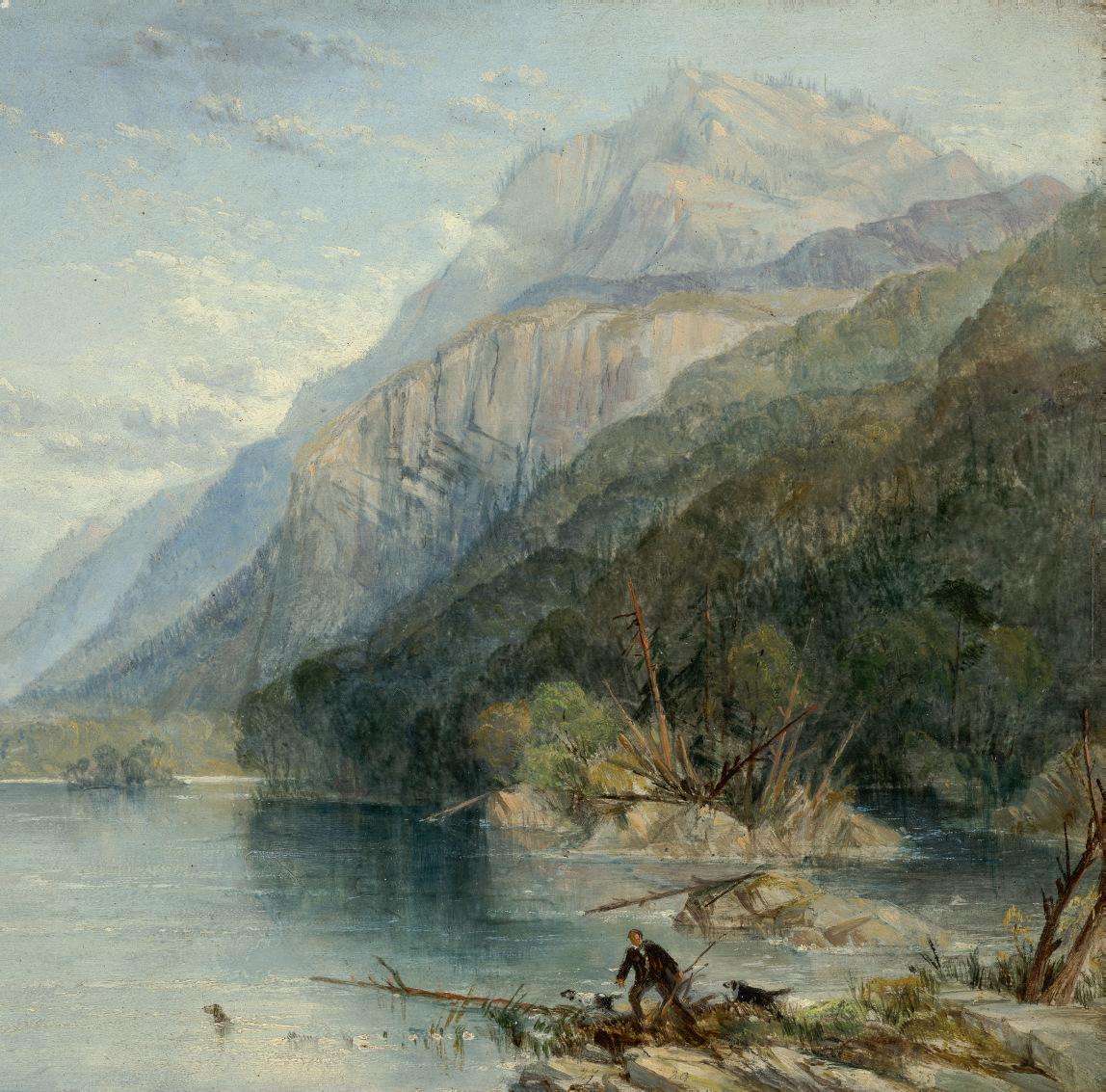
Parti fra Øvre-Telemark (Landscape from Upper Telemark)
signed and dated 'F Sodring./1834' (lower left) oil on canvas
24 x 365/8 in. (61 x 93 cm.)
$8,000-12,000
PROVENANCE:
£6,000-9,000
€7,100-11,000
P. B. Scavenius, Gjorslev, by 1835. Anonymous sale; Kunsthallen, Copenhagen, 25 February 1997, lot 99, as Parti fra Øvre-Telemarken
Acquired at the above sale by the present owner.
EXHIBITED:
Copenhagen, Charlottenburg, Fortegnelse over de ved det Kongelige Akademie for de skjönne Kunster, 1835, p. 9, no. 133, as Parti af Lilleland i Øvre-Telemark i Norge.
LITERATURE:
L. Vestergaard, 'Landskabsmaleren Frederik Sødring', Kunstmuseets årsskrift, vol. LXIV-LXVII, Copenhagen, 1981, p. 61, no. 47, as Parti af Lilleland i Øvre-Telemark.
Frederik Sødring was a pupil of Jens Peter Møller. He had close relationships with several students of Eckersberg, mainly with Købke from whom he learned the keen view on Copenhagen's topography. Købke painted a portrait of him in the studio they shared in the early 1830s. Sødring's work reveals two distinct concepts of landscape, both 'German' and 'Danish'—not necessarily as a result of his own work but probably dictated by the artistic environment at the time.
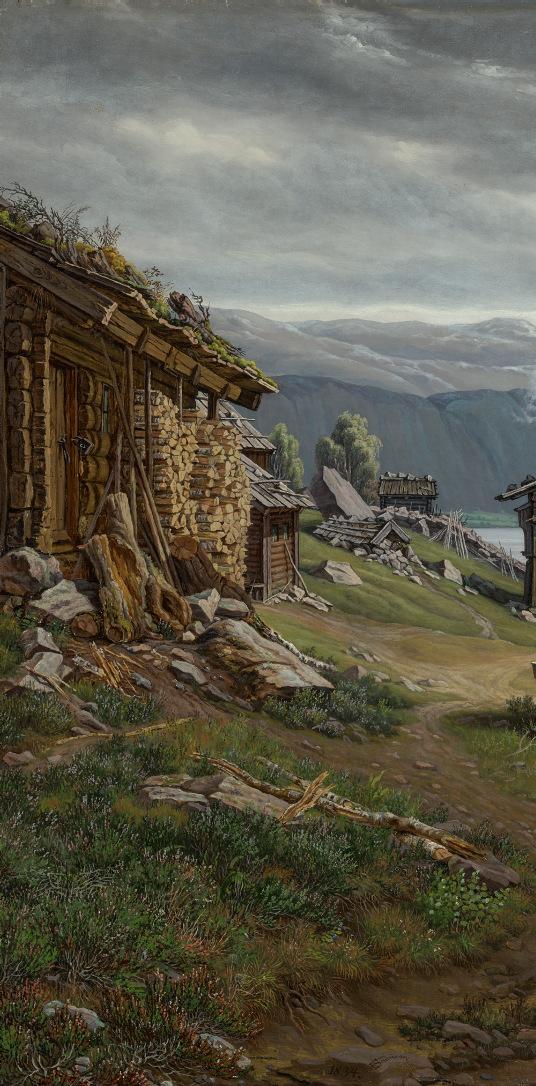
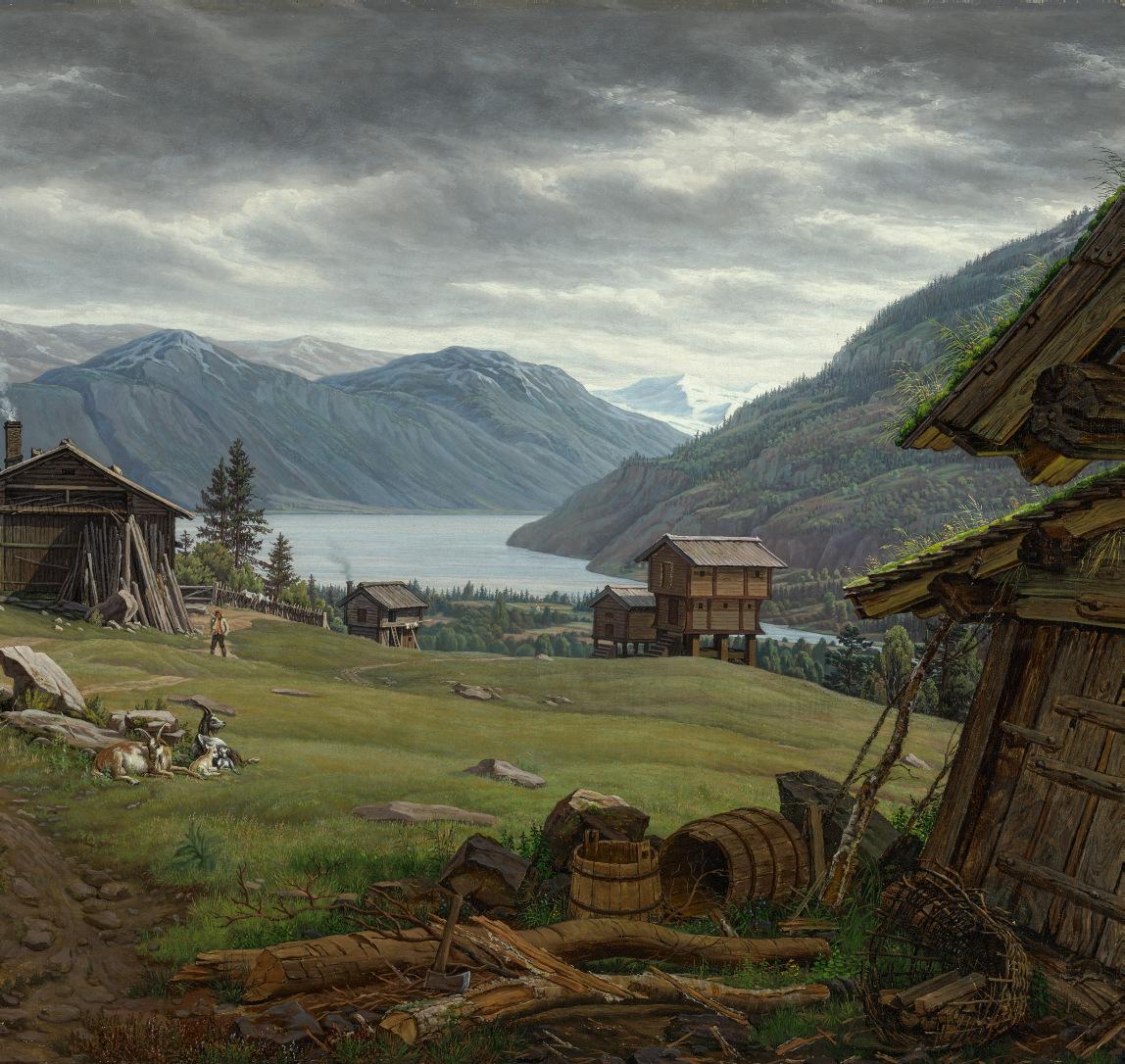
View of the Mårelv near Tinn
signed and dated 'Dahl/1833.' (lower center, on the rock) oil on canvas
9¿ x 12º in. (23.3 x 31.1 cm.)
$30,000-50,000
PROVENANCE:
Fr. Hesselberg, Oslo, by 1888. Henri Konow (1862-1939), Nysø, Denmark. Private collection, Denmark, by 1987.
£23,000-37,000
€27,000-44,000
Anonymous sale; Kunsthallen Copenhagen, 2 December 1998, lot 20, as Maarelven ved Tinn
Acquired at the above sale by the present owner.
EXHIBITED:
Bergen, Exercerhuset, J. C. Dahl, Commemorative Exhibitions in Bergen and Christiania, 1888, no. 55; also Christiania (Oslo), no. 48.
LITERATURE:
M. Lødrup Bang, Johan Christian Dahl 1788-1857, Life and Works, Oslo, 1987, vol. 2, p. 233, no. 726, vol. 3, pl. 306, no. 726, illustrated.
Though he spent most of his life outside of his native Norway, Dahl is considered ‘the father of Norwegian landscape painting.' The artist was born into a family of modest means in Bergen, and because Norway lacked a national Academy to train artists, Dahl’s travel and schooling at the Danish Academy were financed by a group of well-to-do local citizens who noticed the young artist’s talent. In 1826, the artist was able to return to Norway for the first time since he had left 15 years prior for Denmark. During this trip he made the drawing which provided the basis for the present painting, which was completed in 1833. Dahl held that a landscape painting should not just depict a specific view but should also say something about the land itself–the greatness of its past and the life and work of its current inhabitants. Dahl’s love for his native land is clear in the motifs he chose for his paintings of Norway and in his extraordinary efforts on behalf of Norwegian culture generally.

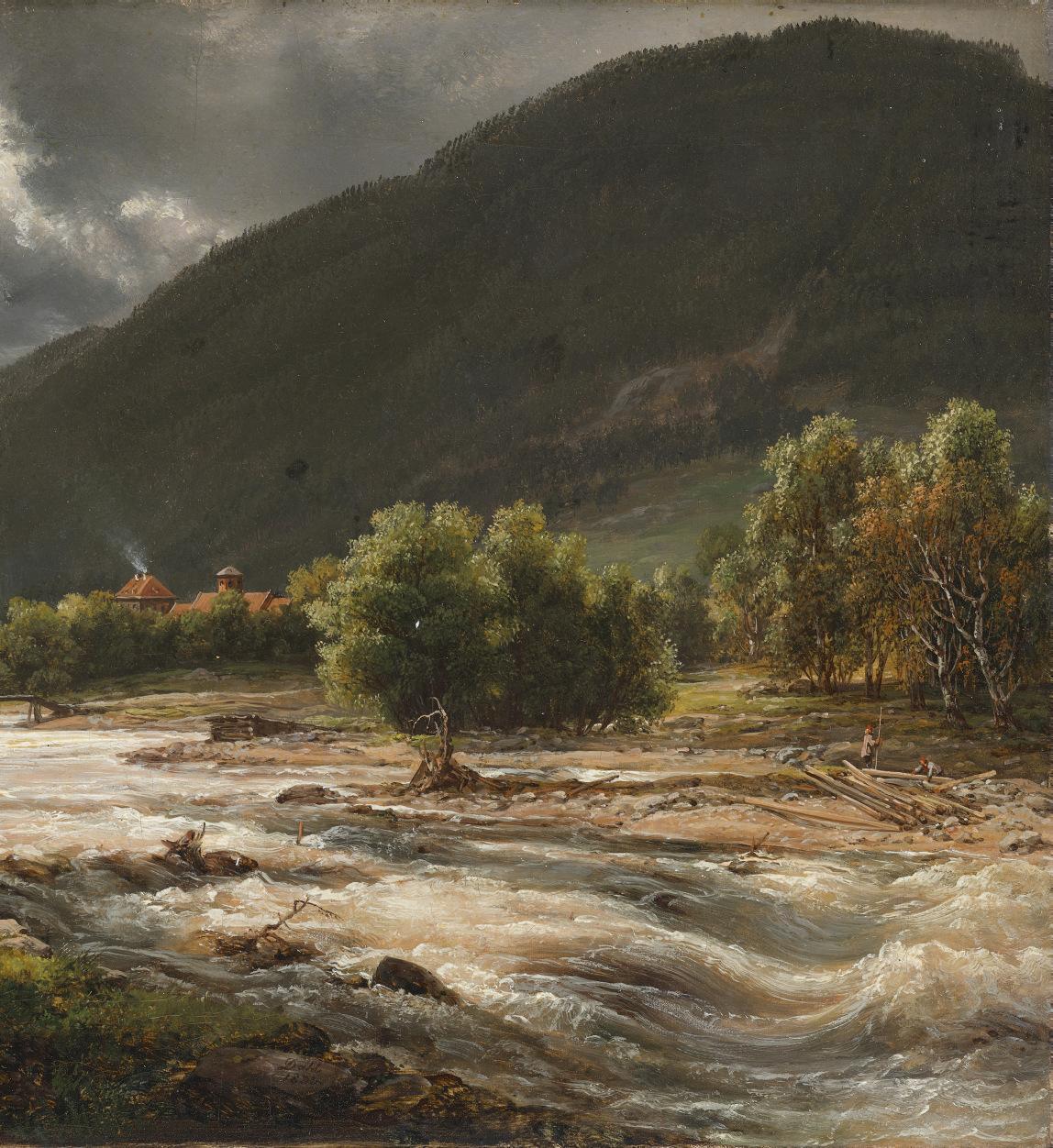
signed and dated 'L A Ring/1905' (lower left) oil on canvas
27Ω x 22Ω in. (70 x 57.2 cm.)
$30,000-50,000
PROVENANCE:
Samuel Wulff, by 1910. with Christian Larsen, by 1914. Ludvig Karsten (1876-1926), Paris.
£23,000-37,000
€27,000-44,000
His sale; Winkel and Magnussen, Copenhagen, 4 December 1928, lot 131, as En Mand gaaende i en Rugmark.
Peter Thomsen, Landskrona, by 1933.
His sale; Kunsthallen, Copenhagen, 16 May 1950, lot 39, as En Mand gaaende i en Rugmark.
Anonymous sale; Kunsthallen, Copenhagen, 23-24 March 1983, lot 182.
Private collection, acquired at the above sale.
Anonymous sale; Christie's, London, 21 June 1985, lot 51, as Old Man Walking in a Rye Field.
HSBC Corporate Art Collection. Their sale; Sotheby's, London, 13 June 2006, lot 166. Acquired at the above sale by the present owner.
EXHIBITED:
Copenhagen, Kunstforeningen, Fortegnelse Over Arbeider 19011914 Af L. A. Ring Udstillede I Kunstforeningen, March-April 1914, p. 6, no. 41, as En Mand Set Fra Ryggen Gaaende I En Rugmark. Copenhagen, Charlottenborg, Mindeudstillingen for L. A. Ring, November 1933, no. 157, as En Mand gaaende ved en Rugmark. Copenhagen, Ordrupgaard, L. A. Ring, 12 April-11 June 1984, pp. 97, 126, no. 86, illustrated, as Mand, set fra ryggen, gående i en rugmark.
LITERATURE:
H. C. Christensen, Fortegnelse Over Malerier Og Studier Af L. A. Ring I Aarene 1800-1910, Copenhagen, 1910, p. 81, no. 548, as En Mand gaaende i en Rugmark.
P. Hertz, Maleren L. A. Ring, Copenhagen, 1934, pp. 360, 386, as En Bondemand mellem Rugmarker.
H. Wivel, L.A. Ring: Dansk Klassikerkunst, Copenhagen, 1997, pp. 52-53, fig. 30, illustrated, as Mand i Rugmark. Baldersbrønde. E. M. Fonsenius, Maleren Laurits Andersen Ring, Hellerup, 2021, p. 81, no. 70, illustrated, as Gammel mand gående i en rugmark.
Laurits Andersen Ring was born in the village of Ring in South Zealand, Denmark. He was to become one of the finest Danish painters of his generation, no mean feat in a generation of painters which included such notable names as his friend Vilhelm Hammershøi, Carl Holsøe, Peter Ilsted, and Peder Mørk Monsted. Ring’s rural childhood and adolescence meant he grew up in humble circumstances, and the farmers and fieldworkers he knew as a young man served as a source of inspiration throughout his life. Unlike other painters of the 19th century who romanticized farm life and viewed it as the antidote to the troubles of modernity, Ring seems to express little judgement about the progress of modernity and industrialization that was a hallmark of his time, capturing what was before him simply as a Realist. Ring believed passionately that the workingclass people in Denmark deserved better treatment (the artist was an avowed Socialist and revolutionary in his youth), and depicting working people with a dignity and a monumentality was foremost on the artist’s mind in selecting his subject matter.
Henry Wivel praised L. A. Ring as 'the painter of roads par excellence within Danish art' (H. Wivel, L.A. Ring, Copenhagen, 1997, p. 50), and in the present work the dirt path cutting centrally through the picture plane provides a framing device for the Rückenfigur of an old man walking through the field. Slightly stooped, and walking with the aid of a cane, he is still a figure of dignity, taking up almost the entire center of the canvas while the sea of rye seems to part before him. Ring omits almost all details of the setting other than the roof of a house just visible over the tops of the stalks of grain, keeping the focus on the figure and the landscape. Like many of the artist’s paintings it can be understood both literally and symbolically–an old man returning home after a day of work, but also a symbolic representation of man at the end of his life, walking away from the living and returning to home and to the land.

signed and dated 'L. Zorn 1879' (lower right); signed and dated 'LZorn/79' (with first two letters conjoined, incised in the wet paint with the back of the brush, upper right) oil on canvas
46√ x 28æ in. (119.1 x 73 cm.)
$50,000-70,000
PROVENANCE:
The sitter.
By descent through her family.
£38,000-52,000
€44,000-61,000
Anonymous sale; Bukowski's Stockholm, 27 May 1998, Lot 223, as 'Bertha'. Fröken Bertha Dölling
Acquired at the above sale by the present owner.
LITERATURE:
G. Boëthius, Zorn: Tecknaren, Malaren, Etsaren, Skulptoren, Stockholm, 1949, pp. 62, 75, 536, as Fru Bertha Wawrinsky
The present painting is an early portrait by the artist who would come to be regarded as Sweden’s master portraitist. Though born into humble circumstances and out of wedlock, Zorn was acknowledged by his father, a brewer, which opened doors for the young artist, particularly once his artistic aptitude became apparent. Following his father’s death in 1874, he received an inheritance which sustained his living expenses and school fees for several years. In 1875, Zorn moved to Stockholm to continue his artistic education. He initially trained as a woodcarver in the School for Handicraft and later transitioned to the Royal Academy of Fine Art’s preparatory school to study painting, drawing and sculpture. The financial support he had been receiving from his inheritance came to an end in 1878, the year he entered the Academy, but inspired by the artist’s mother, who had sent Zorn’s drawings to several of his late father’s friends, a collection had been taken up on his behalf which allowed him to carry on with his education. In 1879 Zorn completed his studies, and it was in the same year that the present portrait was made.
Among the young Zorn’s supporters were the Dölling family, also a brewing family, who lived in the Stockholm archipelago. In 1872, the year Zorn’s father became aware of his birth and acknowledged him as his son, the Döllings hired Zorn’s mother as a gardener, and offered the two a place to live where Zorn could learn to speak Swedish, as he only spoke his local Mora dialect. His mother sacrificed all her best clothes so that Zorn could be dressed well to be seen in polite society, and allowed him to play with the Dölling children rather than joining her in her work. During and immediately following his studies Zorn painted several portraits of the Dölling children, primarily in watercolor–a watercolor study of the present painting is also known. Boëthius identifies this painting specifically as being painted on New Year's Day of 1879. This large-scale oil is undoubtedly the most impressive statement of all of Zorn’s portraits of the Dölling children, reflecting the artist’s ambitions for his future, but he must have also seen it as a sincere gesture of thanks for the family’s years of support as well. In the following year, 1880, Zorn would paint In Mourning, the work that would begin the launch of his career to its meteoric heights.

Tummeliten med Brev (Hop-o'-My-Thumb with Letter)
signed 'JENNY NYSTRÖM' (lower left and lower right); inscribed and dated 'Tummeliten 1904' (on the reverse)
watercolor, pen and gouache over pencil on paper
17º x 12æ in. (43.8 x 32.4 cm.)
$3,000-5,000
PROVENANCE:
Anonymous sale; Bukowskis, Stockholm, 27 May 1998, lot 158. Acquired at the above sale by the present owner.
£2,300-3,800
€2,700-4,400

Grande Nature Morte au Pichet
oil on panel
17Ω x 25Ω in. (44.5 x 64.8 cm.)
$40,000-60,000
PROVENANCE:
Dr. Leonard Gow (1859–1936), Glasgow, before 1928. His sale; Christie's, London, 28 May 1937, lot 65, as Still Life. Ian McNicol (1908-1979), Glasgow, acquired at the above sale. Private collection, UK.
Donated to support Cancer Relief, Macmillan Fund by the above. Their sale; Christie's, London, 29 June 1992, lot 3.
Acquired at the above sale by the present owner.
EXHIBITED:
Kirkcaldy, Fife, Kirkcaldy Galleries, Loan Exhibition, July-August 1928.
LITERATURE:
Christie's Review of the Season 1992, p. 78, illustrated.
£30,000-45,000
€36,000-53,000
Most of Monticelli’s still life paintings were made between 1875 and 1885, and the patterned blue and white striped tablecloth shown here is also seen in the artist’s Still Life: Fruit and Still Life: Oysters, Fish, and A Vase of Wild Flowers (both in the National Gallery, London), Still Life with Fruit and Wine Jug (Art Institute of Chicago) and Nature morte au pichet blanc (Musée d'Orsay), which further underscores their contemporaneous dating.They also tend to use the same studio props, including the wine glass, pitcher, and knife found in the present work as well. Marc Stammegna believes that this work was the première pensée for the work now in the Musée d'Orsay and remained unsigned because it was retained in the artist's studio.
A highly original painter of portraits, still lifes, and landscapes, Adolphe Monticelli trained in Paris with academic painters, copied works in the Louvre by Giorgione, Rembrandt, and Paolo Veronese, and befriended Eugène Delacroix, with whom he shared an intense fascination of color. The loose brushwork and textured surfaces that characterize Monticelli’s paintings greatly influenced modern artists like Paul Cézanne, Vincent van Gogh, and the Fauves. Van Gogh, who owned six of Monticelli’s paintings, also identified with the myth of the misunderstood artist from Provence that rapidly grew around Monticelli after his death in 1886. Indeed, the artist played a role in Van Gogh’s decision that same year to travel to the South of France, where he hoped to find the source of Monticelli’s light. He hoped that his own paintings—with their brilliant color and thick impasto—might be better understood as a continuation of Monticelli’s late work. Cézanne, who was friends with Monticelli, was similarly an admirer of his use of impasto as well as the directional brushstrokes of his later work. The position of the table in the present work, placed parallel to the picture plane, recalls similar still lifes by Cézanne painted in the late 1880s.
We are grateful to Marc Stammegna for confirming the authenticity of the work and for his assistance with this catalogue entry. This work will be included in his catalogue of Monticelli's still lifes and flower paintings, currently in preparation.


signed 'A. Vollon' (lower right) oil on panel
24¬ x 20 in. (62.7 x 50.8 cm.)
$10,000-15,000
PROVENANCE: with H. Shickman Gallery, New York, by October 1971. Joey (1932-2022) and Toby Tanenbaum, Toronto. Their sale; Sotheby's, New York, 18 March 1998, lot 139. Acquired at the above sale by the present owner.
EXHIBITED:
£7,500-11,000
€8,800-13,000
New York, H. Shickman Gallery, The Neglected 19th Century: An Exhibition of French Paintings, October 1971, unnumbered, as Still Life With Flowers.
We are grateful to Dr. Carol Tabler for confirming the authenticity of this work and for her assistance in preparing this catalogue entry.
